Abstract
This article reviews 98 aggregate and multilevel studies examining the associations between income inequality and health. Overall, there seems to be little support for the idea that income inequality is a major, generalizable determinant of population health differences within or between rich countries. Income inequality may, however, directly influence some health outcomes, such as homicide in some contexts. The strongest evidence for direct health effects is among states in the United States, but even that is somewhat mixed. Despite little support for a direct effect of income inequality on health per se, reducing income inequality by raising the incomes of the most disadvantaged will improve their health, help reduce health inequalities, and generally improve population health.
Several overarching theories have been proposed as frameworks to understand differences and trends in population health (Schofield, Reher, and Bideau 1991). One of the most prominent is McKeown's thesis that better nutrition is the most important factor in explaining mortality declines in 19th-century Britain (McKeown 1976; Szreter 1988, 2002a). According to Easterlin (1999), it is commonplace in economics to believe that improvements in population health are mostly a serendipitous byproduct of economic growth, that there is little left to be discovered about the production of population health not covered by understanding the production of wealth. Preston proposed that it is not improved nutrition, rising incomes, or better standards of living but more efficient public health technology that is most important to explaining rising life expectancies among poor countries during the 20th century (Preston 1976). Caldwell (1986) pointed out the importance to better population health of female autonomy, the education of women, and maternal and child health services. Subsequently, health behaviors (McGinnis and Foege 1993), medical treatment (Bunker, Frazier, and Mosteller 1994), and, more recently, genetic explanations (Venter et al. 2001) have been offered to understand health differences within and among populations.
Over the last decade the income inequality hypothesis has vied for a place among these “meta-theoretical” frameworks for the determinants of population health (Davey Smith and Egger 1996). This research theme has coincided with concerns over the extent of income inequality between the rich and poor within countries, and the economic inequality between rich and poor nations. This interest in the health effects of income inequality has also coincided with the long-standing epidemiological interest in whether physical and, more recently, social environmental characteristics—not conceptualized or measurable as characteristics of individuals, but as characteristics of places or aggregates of people—can affect the health of individuals (Diez-Roux 1998).
There has been ample discussion in both academic and popular circles about the extent and consequences of the growing income inequality within and among countries. It is widely acknowledged that income inequality rose markedly in wealthy nations starting in the 1970s, with increases of 20 to 30 percent observed in several countries, including the United States and the United Kingdom (Atkinson, Rainwater, and Smeeding 1995; Lindert 2000).
Figure 1 shows U.S. trends in income inequality (measured by the household Gini coefficient1) and poverty from 1913 to 1996 and age-adjusted total mortality from 1900 to 1998. The income data for 1913 to 1946 are projections (for details of the projections, see Plotnick et al. 2000). These trends have several noteworthy features. First, the largest change in income inequality in the 20th century was the rise during the interwar period and the Depression, followed by large declines during and after World War II. Second, after World War II, income inequality was relatively stable compared with that of earlier periods. Thus, the recent increases that have drawn so much attention are rather modest compared with the huge declines after the late 1930s that helped establish the advantageous economic conditions for the baby-boom generation. This does not trivialize the potential negative impacts of more recent increases in income inequality (Kawachi and Kennedy 2002), but it is important to consider that if exposure to high levels of income inequality is to be considered a major determinant of population health, these recent increases are modest when compared with the historical record. Third, trends in income inequality are broadly consistent with trends in poverty, so that the massive reduction in income inequality also coincided with declines in adult poverty and the establishment of other broad-based welfare state policies, such as Social Security in 1935. Thus, it appears that income inequality is tightly linked to other aspects of social policy, and this may make it difficult to isolate its independent effects on health and complicates the task of deciding which particular economic and social policy interventions are likely to benefit population health.
Figure 1.
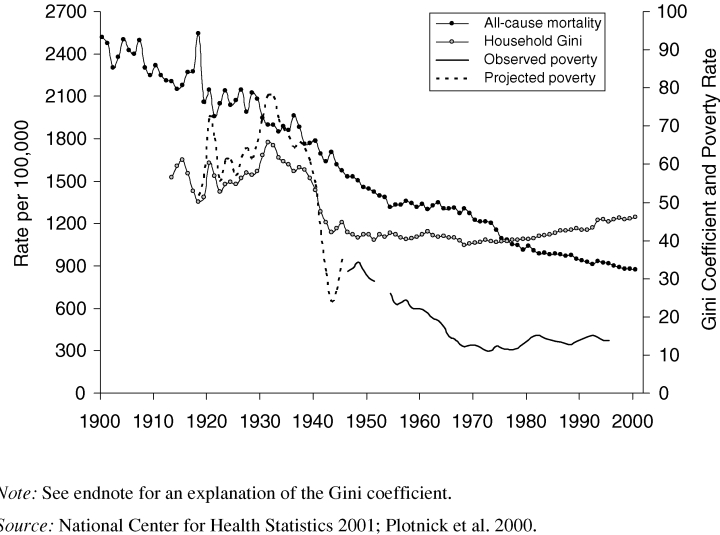
Household Income Inequality and Poverty, 1913–1996, and Age-Adjusted All-Cause Mortality, U.S., 1900–1998
We use the term health in this article with the understanding that it is a complex outcome that can be measured across a continuum of general to specific indicators. Among general indicators are life expectancy, quality of life, self-rated health, and all-cause mortality; among more specific measures are infant mortality, specific causes of death, depression, and violence. Most of the research on income inequality and health has not addressed how income inequality might be specifically linked to different outcomes in different ways and at different times (Lynch and Davey Smith 2003; Lynch, Harper, and Davey Smith 2003). Although we discuss the issue of etiological specificity later, readers should be aware that our use of the generic term health when reviewing the income inequality literature is necessarily somewhat vague because the term has been used to refer to a variety of indicators, the most common being self-rated health, life expectancy, all-cause mortality, infant mortality, and violent crime.
The editors of BMJ (formerly the British Medical Journal) called the income inequality–health hypothesis a “big idea”:
The big idea is that what matters in determining mortality and health in a society is less the overall wealth of that society and more how evenly wealth is distributed. The more equally wealth is distributed the better the health of that society. One political implication, appealing to those on the left, is that the best way to improve health in a society might be to take measures to distribute wealth as equally as possible.
This idea is important because of its relevance to achieving greater social justice and better population health through redistributive fiscal and tax policies. If we accept the notion that income inequality is a determinant of population health, then the implication is that the inhabitants of those places that deliberately even out individuals’ life chances by distributing income more equally will be more healthy overall. This is an appealing, intuitive, and policy-relevant idea (Kawachi and Kennedy 2002).
Should income inequality, then, be included on a list of the major determinants of population health? Research findings that are inconsistent with the income inequality–health hypothesis have begun to appear (Deaton and Lubotsky 2003; Lynch et al. 2001; Mellor and Milyo 2001; Osler et al. 2002; Shibuya, Hashimoto, and Yano 2002), resulting in comments that “evidence for a correlation between income inequality and the health of the population is slowly dissipating” (Mackenbach 2002, 2). Because it seems that this research theme is at something of a crossroads (Lynch and Davey Smith 2002; Pearce and Davey Smith 2003), it is timely to review its development and describe the state of knowledge of the importance of income inequality as a determinant of population health.
First we explain the income inequality–health hypothesis. We then systematically review the empirical evidence and elaborate on some of the issues that arise in this literature. We conclude with a summary of the current evidence for income inequality as a determinant of population health.
The Development of the Income Inequality–Health Hypothesis
It is widely accepted that at the individual level, higher incomes—and other markers of socioeconomic circumstances—are associated with better health (Lynch and Kaplan 2000). This relationship is found for many but not all disease and morbidity outcomes and across many but not all places and over many but not all time periods. While the consistency of this association is important and is emphasized by most researchers (Adler et al. 1994), it is often couched in terms of a psychosocially mediated general susceptibility of the disadvantaged. But it may be also helpful to examine the heterogeneity in the strength and direction of these associations because this heterogeneity may be etiologically informative in mechanistically specific ways (Davey Smith, Ben-Shlomo, and Lynch 2002; Davey Smith, Gunnell, and Ben-Shlomo 2001; Davey Smith and Lynch 2004; Leon 2001).
The relationship between income and health at the individual level involves more than poverty. Every step up the socioeconomic ladder is generally associated with an increment—albeit a diminishing one—in better health. In other words, there is an individual-level gradient. Furthermore, with the analysis of large data sets that follow individuals in general populations over time, evidence has converged around the general conclusion that socioeconomic disadvantage precedes poorer health (Blane, Davey Smith, and Bartley 1993). This does not exclude reverse causation—poor health does affect earnings—but it is not the primary mechanism behind the association between income and health. The most persuasive studies have been prospective analyses of large, representative cohorts (Backlund, Sorlie, and Johnson 1996; Ecob and Davey Smith 1999; Sorlie, Backlund, and Keller 1995). For example, Wolfson and colleagues (Wolfson et al. 1993) looked at the relationship between past earnings and mortality for more than half a million male retirees and contributors to the Canada Pension Plan. Figure 2 shows the relationship between mortality in the 65-to-70 age range and each individual's average level of earned income between ages 45 and 65. The graph shows a clear gradient. We should note that these are longitudinal data, so they show the connection between income as early as age 45 and mortality experienced decades later, after age 65. For the majority of cases, the causality must run from income to mortality and not the other way around. Thus, the evidence for a causal effect between individual-level income and individual health seems compelling, albeit through complicated pathways over the lifecourse (Davey Smith and Lynch 2004).
Figure 2.
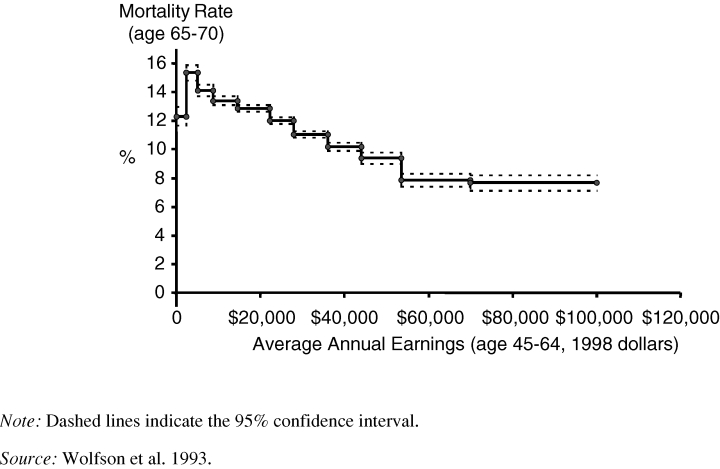
Average Annual Income and Mortality Rate for 500,000 Canadian Men
If countries are the units of analysis, the patterns are similar. Figure 3 shows the well-known association between gross domestic product per head (GDP) and life expectancy. The curvilinear shape implies that above a certain GDP threshold, the association between absolute income and health weakens, so that the variation in population health among richer countries (illustrated in the circle) is not as tightly linked to average income. Among these richer countries, the strength of the association with GDP depends crucially on which countries and time periods are included (Lynch 2000; Lynch et al. 2000b; Lynch et al. 2001). Nevertheless, it is precisely this unexplained variation in average levels of health among affluent nations that first led to the reasoning that if it was not average income, then perhaps it was the distribution of income within these countries that helped explain why some countries had better levels of health than did others (Preston 1975).
Figure 3.

GDP per Capita and Life Expectancy for 161 Countries, 2000
In his seminal 1975 paper, Preston examined the association between per capita national income and life expectancy at birth for three different decades of the 20th century. He demonstrated that life expectancy in the 1900s, 1930s, and 1960s exhibited a nonlinear relationship with per capita national income, which had shifted upward during the 20th century. Preston made several points in discussing the findings that are pertinent to our article. First, he proposed that the upward “shifts” in the life expectancy/income association were due mainly to exogenous factors that strengthened the public health infrastructure (immunization, technological advances, and specific disease-control campaigns) rather than income growth per se. In other words, the same level of GDP purchased more health than it did in previous periods, without changing the basic association between the two. Second, Preston suggested that life expectancy became progressively more dissociated from absolute income and that at least some of the variation in life expectancy among richer countries may be due to variations in income distribution. While Preston could not examine this issue directly, he did explain that because the association between income and life expectancy was asymptotic at the individual level, those persons with incomes below the average lost more years of life than were gained by those persons with higher than average incomes. Preston concluded that “the distribution of income is clearly a likely source of variance in the basic relation between national life expectancy and average national income” (Preston 1975, 242).
In 1979, Rodgers elaborated on how income distribution was associated with population health. In a sample of about 50 countries, he tested a regression model that predicted infant mortality and life expectancy at birth and at age five as a function of mean income and income distribution. Rodgers's overall concern was to try to predict mortality change, especially in regard to developing countries, and he touched on many of the issues that have since occupied researchers in this field. He recognized that specific factors like clean water, sanitation, food supply, and health care—aspects of the health-enhancing infrastructure—were important but empirically difficult to disentangle because they tend to be highly collinear with one another and with income. That realization certainly remains salient today (Lynch and Davey Smith 2002). Rodgers also noted that disentangling their specific contributions was important for policy formulation, but not “critical for a description of mortality changes in the process of development” (Rodgers 1979, 343). Because he was interested in predicting such mortality changes, he set aside the messy issues of figuring out appropriate confounders and specifying causal pathways that might link aspects of development, income, inequality, and population health. Rodgers also demonstrated theoretically how a curvilinear individual-level association between income and health was sufficient to produce an aggregate-level association between lower income inequality and better population health. Gravelle (1998) later named this the “artefact” explanation for how lower income inequality could be associated with better population health, and in their review, Wagstaff and van Doorslaer (2000) termed this the absolute income hypothesis. (See the International Journal of Epidemiology where Rodgers's original paper has been republished with several commentaries: Deaton 2002; Lynch and Davey Smith 2002; Porta, Borrell, and Copete 2002; Wilkinson 2002).
Rodgers examined different characterizations of the income and inequality variables in regard to life expectancy and infant mortality. He was concerned primarily with the statistically efficient predictive capacity of the models, not whether they were causal representations. Indeed, he offered no substantive interpretation of his findings and clearly left open the possibility that associations between income inequality and health could be due to confounding by health and social services, including education. Nevertheless, he argued that there was a five-to-10-year difference in life expectancy between relatively egalitarian and inegalitarian countries. In this way, the first empirical plank in the income inequality–health hypothesis was in place.
In a series of papers starting in the mid-1980s, Richard Wilkinson demonstrated important associations between income inequality and differences in mortality among industrialized countries. Wilkinson's work was premised partly on the observations by Preston and his appreciation that the curvilinear association between income and health at the individual level was sufficient to generate an aggregate-level association between income distribution and health. Wilkinson's widely cited 1992 study used income data on nine countries from the first wave of the Luxembourg Income Study (LIS). The LIS is a multicountry study designed to enhance the validity of international comparisons, and its income distribution data are generally recognized as the best in the world (Atkinson, Rainwater, and Smeeding 1995). Wilkinson showed that the percentage of total post-tax and benefit income held by the least well off 70 percent of a country's population was strongly related to life expectancy at birth (r= 0.86) (Wilkinson 1992). This association was not affected by adjustment for average absolute income level and was evident across a range of decile shares of the income distribution (see Figure 4). Furthermore, using two other international data sources, he showed that annual increases in income inequality within a country were associated with slower increases in life expectancy (r= 0.47).
Figure 4.

Income Inequality and Life Expectancy at Birth for Nine Countries (late 1970s–early 1980s)
We need to make two basic points. First, the income inequality–health hypothesis was originally intended to explain variations in average levels of health among richer countries and was later applied to regional health differences within rich countries. The stronger association between absolute levels of income (GDP) and population health among poorer countries may suggest that there is some threshold below which absolute income is the more important determinant. Second, the salience of the curvilinear association between income and health at the individual level has always been central to the income inequality–health hypothesis. Indeed, it was an important motivation for Wilkinson's early investigations.
Different Interpretations of the Income Inequality–Health Hypothesis
The income inequality–health hypothesis has been described in various ways, emphasizing different aspects at different times. Table 1 summarizes how these have been described in the literature. In one authoritative review, Wagstaff and van Doorslaer (2000) defined different versions of the income inequality–health hypothesis: the absolute income hypothesis (AIH); relative income hypothesis (RIH); deprivation hypothesis (DH), which is a variant of the RIH; relative position hypothesis (RPH); and income inequality hypothesis (IIH). The AIH predicts that individual absolute income explains the observed health effects of aggregate income inequality. The RIH predicts that it is income relative to some social group average that is important. The DH is a variant of the RIH and predicts that it is income relative to poverty that is important. The RPH proposes that it is an individual's position in the income distribution that matters. The IIH suggests that there is a direct effect of income inequality on health, that the amount of income inequality in a community matters for health in addition to absolute income. The IIH can be properly tested only by using both individual and aggregate data. Mellor and Milyo (2002) further described “strong” and “weak” variants of the IIH in regard to its predictions about income transfers. The strong version argues that for two individuals, A (with high income) and B (with low income), a transfer of income from A to B will improve the health of both. The weak version of the IIH suggests that such an income transfer will improve the health of B much more than will the reduction of health for A, implying more potent health effects of income inequality among the poor. Mellor and Milyo noted that in the strong version, the health-enhancing effect on individual A seems “ambiguous,” but this is nevertheless what the strong version of the IIH implies. Lynch and colleagues (2000a) offered three broad interpretations of evidence linking income inequality and health: the individual income, the psychosocial, and the neomaterial interpretations. These were intended to explain—by drawing stark, although somewhat artificial, distinctions (Kawachi, Subramanian, and Almeida-Filho 2002)—the evidence linking income inequality to health. The categories of explanation described by Wagstaff and van Doorslaer (2000) and by Lynch and colleagues (2000a) overlap. The AIH is common to both, while the psychosocial and neomaterial interpretations discussed by Lynch and colleagues (2000a) are potential mechanisms for the direct health effects of income inequality under the IIH. Wagstaff and van Doorslaer (2000) concluded that there was strong evidence for the AIH, no evidence for the RPH because it has not been tested, no evidence in support of the RIH, and some evidence consistent with the IIH.
TABLE 1.
Interpretations of Income Inequality Effects on Health
| Hypothesis | Interpretation |
|---|---|
| Wagstaff and van Doorslaer (2000) | |
| Absolute income hypothesis (AIH) | There is no association between income inequality and health after proper control for absolute income at the individual level. |
| Relative income hypothesis (RIH) | It is income relative to some social group average (which social group is undefined) that is important to health. |
| Deprivation hypothesis (DH) | It is income relative to some poverty standard that is important to health. |
| Relative position hypothesis (RPH) | It is an individual's relative position in the income distribution that is important to health. |
| Income inequality hypothesis (IIH) | There is a direct effect of income inequality on health after control for absolute income. |
| Mellor and Milyo (2002) | |
| IIH (strong version) | For two individuals, A (with high income) and B (with low income), a transfer of income from A to B will improve the health of both. |
| IIH (weak version) | An income transfer will improve the health of B much more than the reduction of health for A, suggesting more potent health effects of income inequality among the poor. |
| Lynch et al. (2000a) | |
| Individual income interpretation | As for the AIH above. |
| Psychosocial interpretation (strong version) | Direct health effects of income inequality represent generalizable psychosocial processes that are among the major determinants of population health in rich countries. |
| Psychosocial interpretation (weak version) | Direct health effects of income inequality represent particular psychosocial processes that influence some health outcomes in rich countries. |
| Neomaterial interpretation | Direct health effects of income inequality result from the differential accumulation of exposures that have their sources in the material world and that do not result directly from perceptions of disadvantage. |
In regard to empirical predictions, the absolute income interpretation says that after properly adjusting for individual income, there is no association between income inequality and health. The income inequality hypothesis states that there is a direct health effect of aggregate-level income inequality, which could be due to psychosocial processes based on perceptions of place in the social hierarchy (Wilkinson 1997). It has been argued that such perceptions produce negative emotions like shame and distrust, which are directly and physiologically translated into poorer health via psychoneuroendocrine mechanisms and/or indirectly through stress-induced behaviors like smoking. Simultaneously, perceptions of relative rank and the negative emotions they foster are mirrored in an individual's antisocial behavior and reduced civic participation, which results in less social capital and cohesion within the community. In this way, perceptions of social rank have negative biological consequences for individuals and negative social and health consequences arising from how individuals interact with others. Psychosocial mechanisms thus serve as the explanatory focus linking individual income and aggregate income inequality to individual and social pathology (Lynch et al. 2000a).
The concept of “relative income” or “relative deprivation,” which appears to be at the core of the psychosocial interpretation, has not been clearly defined. Indeed, it is difficult to know with which group(s) people compare themselves in order to gain their sense of relative deprivation, or whether the health losses resulting from an upward comparison with those higher in social rank are larger than the health gains of a downward comparison with those higher in rank. It seems likely that people make multiple comparisons, not only with those in their immediate surroundings, but also with those much more geographically distant, via television, for instance. However, the health saliency of the relative distance of these comparisons is unclear. We know from social cognitive theory concerning role modeling (Bandura 1986) that people are more likely to be influenced by others who are more, rather than less, like themselves. This implies that people take more notice of those who are in some way “closer” to themselves than of those who are further away. That is part of the idea behind using lay educators as instructors/models in outreach and intervention programs. Thus local comparisons may be the most salient, and so it is income or deprivation relative to local standards that is most important. This is consistent with Messner and Tardiff's (1986) discussion of the “frame of reference” as being important to understanding how relative social comparisons work. They argued that comparisons in local communities rather than in nations or states are likely the most important, at least for violence, robbery, and homicide. But clearly these processes of social comparison are complicated, and we may also need to consider how different age, ethnic, or gender groups make these possibly health-damaging comparisons of relative deprivation. It is worth noting here that, if anything, the evidence regarding income inequality suggests that it is when social comparisons are implicitly measured at broader scales that they are more closely associated with health. In the United States, income inequality effects are stronger when measured at the state level than when measured more locally (Subramanian, Blakely, and Kawachi 2003). Moreover, in regard to children's health in the United States, it is poverty relative to a national rather than a state standard that is associated with mortality (Hillemeier et al. 2003).
It is possible to derive “weaker” and “stronger” versions of the psychosocial interpretation of how income inequality affects health. The stronger version suggests that income inequality and its attendant psychosocial processes provide a general explanation and are among the major determinants of health among and within rich countries. A weaker version proposes that income inequality and psychosocial processes may contribute to some health outcomes. This weaker version is, however, difficult to test without more specification of which outcomes are likely to be affected. Otherwise unsupportive evidence may lead to post hoc case-by-case explanations. In the stronger version, claims of generalizable income inequality effects follow from the idea that the main mediator—psychosocial processes—are perception-dependent responses to differences in social rank that would presumably exist in all countries, regardless of actual differences in living conditions between the rich and poor. If this is the main foundation of the psychosocial interpretation, then it implies a universal application. This is perhaps why the evidence from primate studies of stress-disease processes due to lower social rank has consistently been invoked in support of the psychosocial interpretation. Such invocations point to a naturalistic, evolutionary, generalizable process of psychosocial causation based on perceptions of social rank (Wilkinson 2000). However, this animal evidence has sometimes been selectively cited. A recent study by Abbott and colleagues (2003) showed that in some primate species, such as marmosets, subordinates actually have lower levels of the stress hormone cortisol than do dominant animals. Thus the stress effects of dominance hierarchies seem not even to be generalizable across primate species, let alone generally applicable to the health effects of hierarchical human social organization.
The literature on income inequality and health contains claims that are consistent with this stronger version of the psychosocial interpretation of the IIH. Examples are as follows:
If increased income inequality is closely accompanied by a weakening of social bonds, the combination of the two can hardly fail to have a potent effect on health. Partly because of the large proportion of the population exposed to these risks, low social status and poor social relations are probably two of the most powerful risk factors influencing population health.
(Wilkinson 1999b, 262)
Increasingly it looks like the most powerful influences on population health in the developed world are psychosocial.
(Wilkinson 1999a, 492)
To address comprehensively the problem of health inequalities, governments must begin to address the issue of economic inequalities directly. Evidence we sketched earlier indicates that the extent of socioeconomic disparities—the size of the gap in income and assets between the top and bottom of society—is itself an important determinant of the health achievement of society, independent of the average standard of living. … For both of the foregoing reasons—that it yields a higher level of health achievement as well as greater political participation—the reduction of income inequality ought to be a priority of governments concerned about addressing social inequalities in health.
(Daniels, Kennedy, and Kawachi 2000, 29–30)
The relation between smaller inequalities in income and better population health reflects increased psychosocial wellbeing. In rich countries wellbeing is more closely related to relative income than absolute income. Social dominance, inequality, autonomy, and the quality of social relations have an impact on psychosocial wellbeing and are among the most powerful explanations for the pattern of population health in rich countries.
(summary points in Marmot and Wilkinson 2001, 1233)
The fact that the social gradient in health within societies is related to psychosocial factors does not prove that the association between socioeconomic inequality and the health of whole populations also results from psychosocial factors. However, evidence suggests that this is the case.
(Marmot and Wilkinson 2001, 1234)
The strength of such claims has perhaps become more circumspect, diluting them toward the weaker version as research in the field has matured. While it is clear that all of the main proponents of a psychosocial interpretation believe that absolute income and material conditions are important determinants of health (Kawachi and Kennedy 2002; Kawachi, Subramanian, and Almeida-Filho 2002; Marmot and Wilkinson 1999), questions remain about their relative contributions and interrelationships, with different researchers placing different emphases on the importance of absolute income, material conditions, and psychosocial processes. Nevertheless, the stronger version of the psychosocial hypothesis has at times been promoted, thereby attracting enough attention in adjacent disciplines to help motivate a major review paper (Nguyen and Peschard 2003) and to appear in reports sponsored by international and governmental organizations discussing income inequality and the psychosocial determinants of population health (Agren 2003; Bennett 2003; Health Canada 1999; Howden-Chapman and Tobias 2000; OECD 2001; Persson et al. 2001; Turrell et al. 1999). Such deployments of the psychosocial interpretation of the income inequality–health hypothesis would probably not have appeared in these sorts of government reports in the past and so indicates acceptance by the broader research and policy community that the psychosocial interpretation contributes much to a generalizable explanation for health and health inequalities in different contexts.
The neomaterial interpretation of the income inequality hypothesis states that the direct effects of income inequality on health result from the differential accumulation of exposures and experiences that originate in the material world and do not result directly from perceptions of relative disadvantage. The neomaterial and psychosocial hypotheses have a common ground, however, in that both recognize the importance of perceptions and emotions for health-related behaviors. When psychosocial processes are strongly linked to important health behaviors, psychosocial processes are important determinants of population health. The neomaterial interpretation was somewhat clumsily named in order to emphasize that the health effects of material conditions are historically contingent and disease specific (Lynch et al. 2000a). The material conditions relevant to the etiology of infectious diseases in the 19th century are not necessarily the material conditions relevant to the causes of 20th-century chronic diseases, hence neomaterial. A neomaterial interpretation recognizes that the total effect of income inequality on health reflects both a lack of resources held by individuals and public underinvestments in the human, physical, health, and social infrastructure. An unequal income distribution results from historical, cultural, and political-economic processes. These processes influence the private resources held by individuals (money to buy housing, healthy food, opportunities to exercise, medical care) and also shape the nature and availability of a health-supportive public infrastructure—the types and quality of education, health services, transportation, environmental controls, food availability, recreational facilities, housing stock, occupational health regulations—that form the structural matrix of contemporary life influencing health. It is likely that such a structural matrix of living conditions is especially important to the health of the most disadvantaged persons who have fewer individual resources. Thus income inequality may be a manifestation of a cluster of structural conditions that affect population health. This implies that a relationship between income inequality and health is not inevitable, that associations are contingent on the level and distribution of other social resources (Davey Smith and Egger 1996; Lynch et al. 2000a; Lynch et al. 2001).
A Systematic Review of Studies of Income Inequality and Health
Table 2 shows the international and within-country, aggregate, and multilevel studies examining associations between income inequality and health. These were compiled from an electronic review and our own files. We identified 98 studies and included only those that were peer-reviewed. Although this is the most complete review to date, we may have missed one or two. In addition, we did not include those studies examining income inequality and homicide that were reviewed by Hsieh and Pugh (1993). Their review looked at 34 studies demonstrating consistent correlations between income inequality and violent crime, robbery, and homicide. The associations were stronger among nations and U.S. states and between income inequality and homicide rather than robbery. However, we did not examine all the individual studies of homicide to see whether the reported associations were adjusted for such obvious potential confounders as poverty or average income.
TABLE 2.
Empirical Studies of Income Inequality and Health
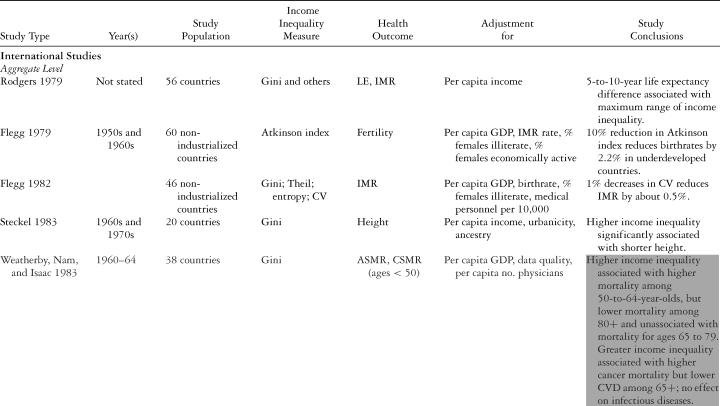
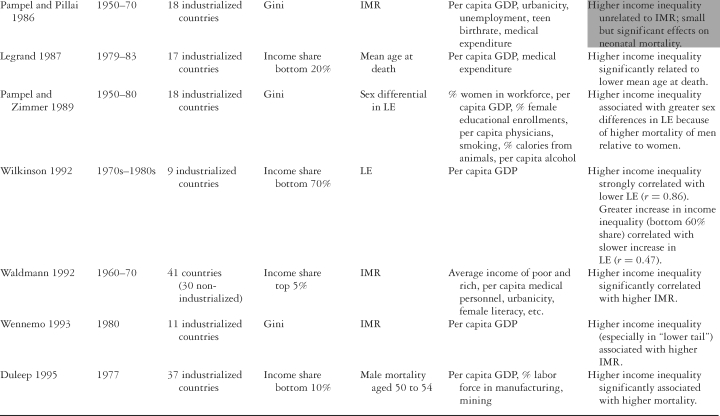
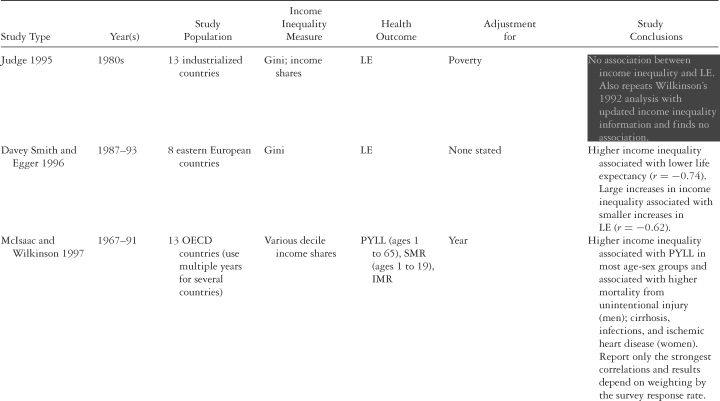
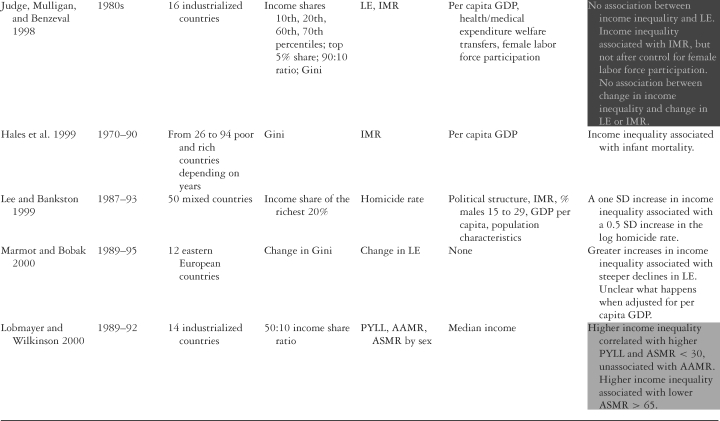
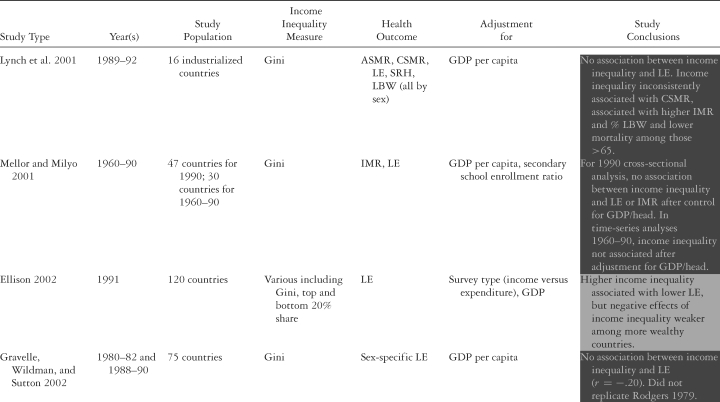
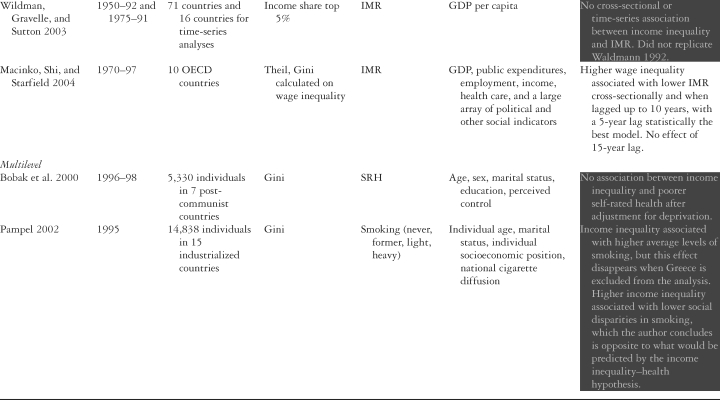
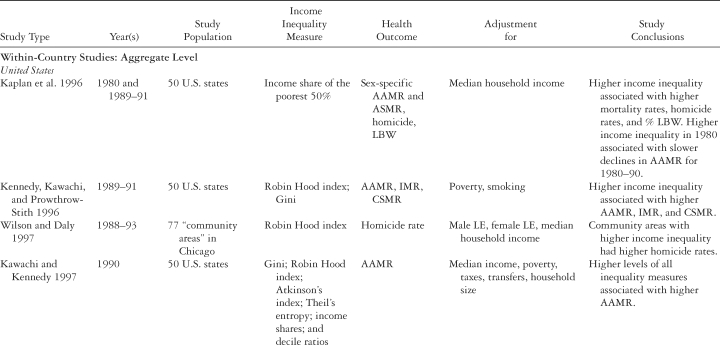
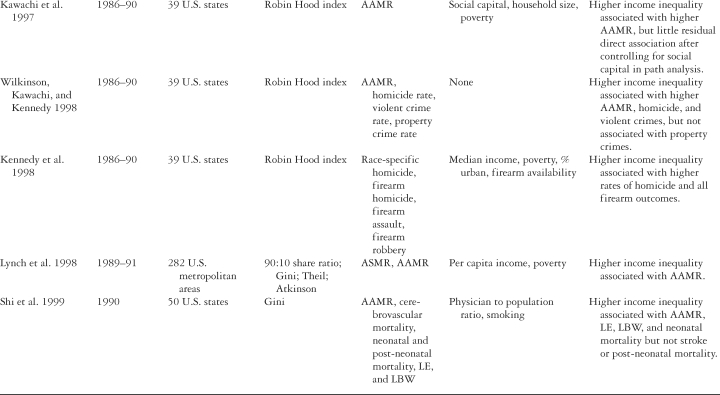
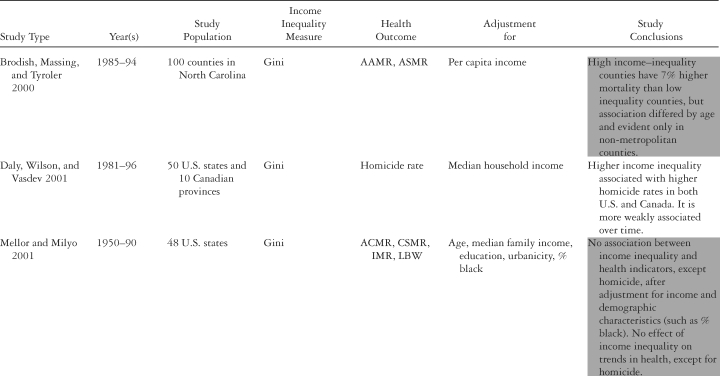
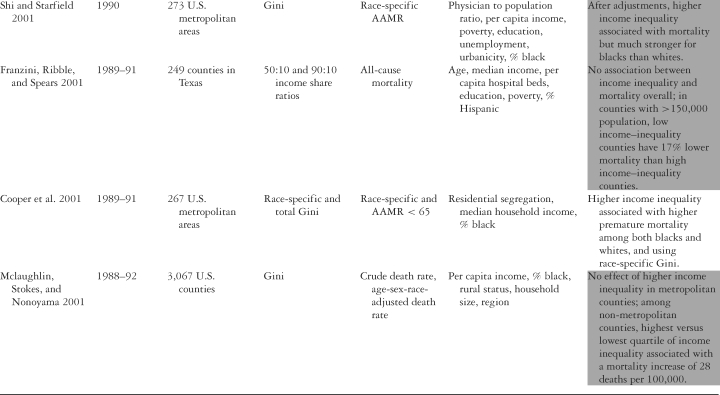
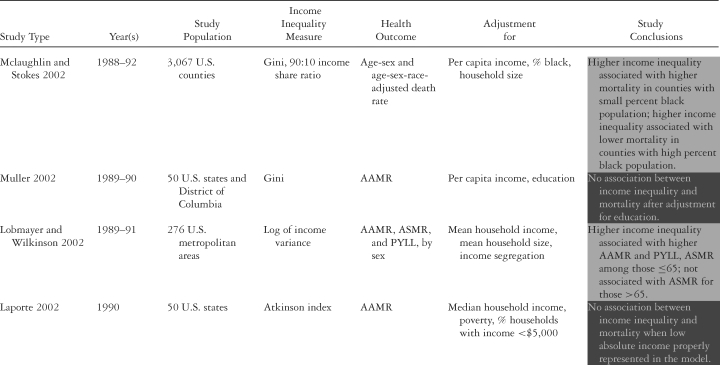
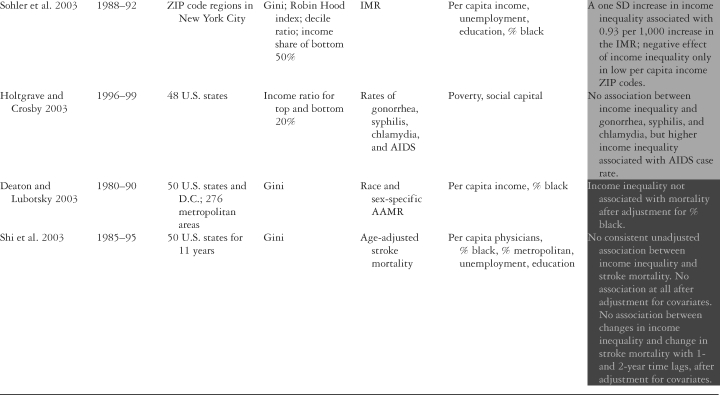
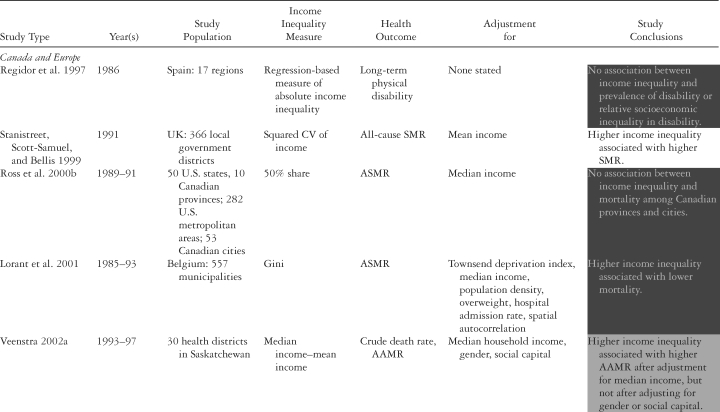
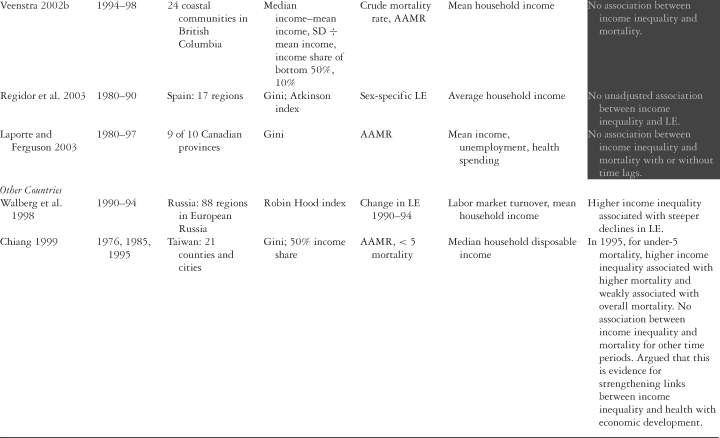
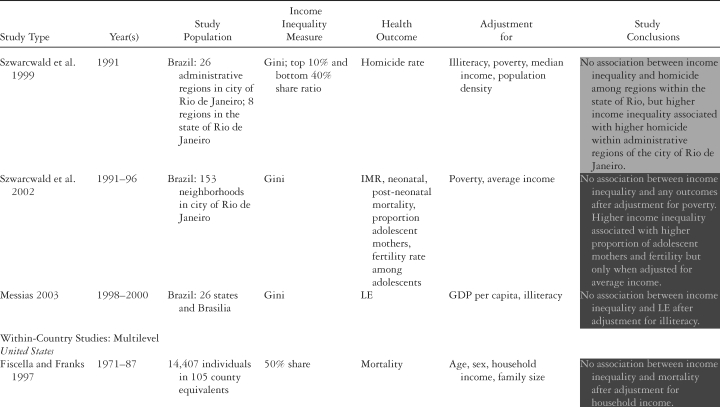
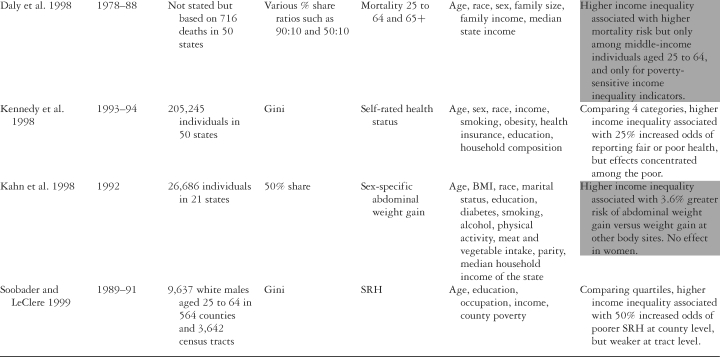
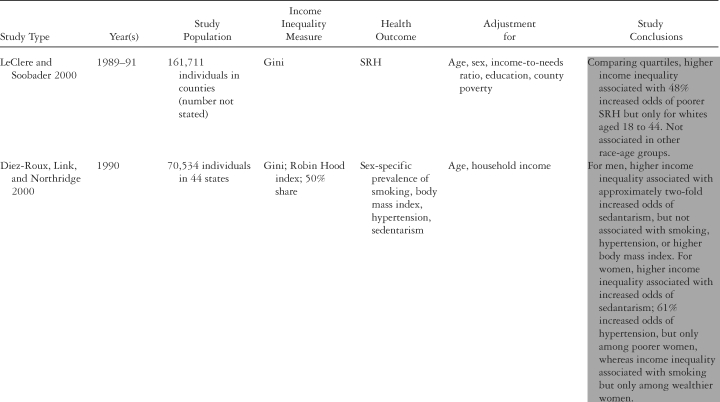
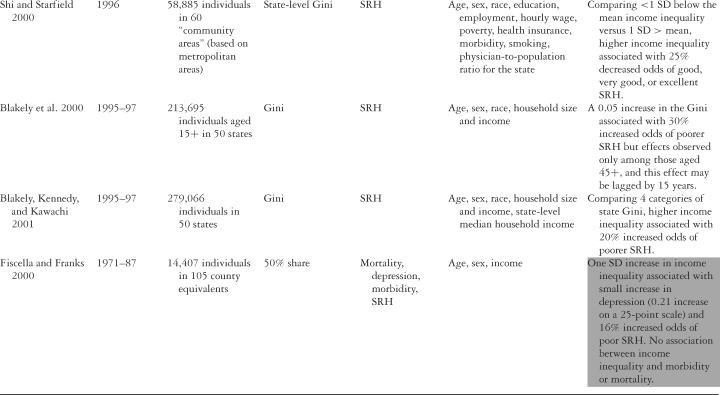
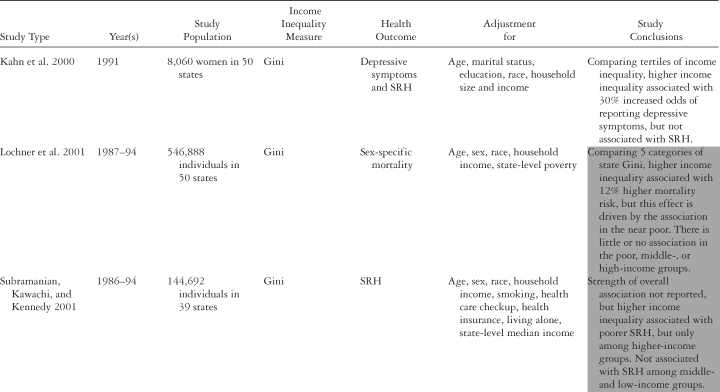
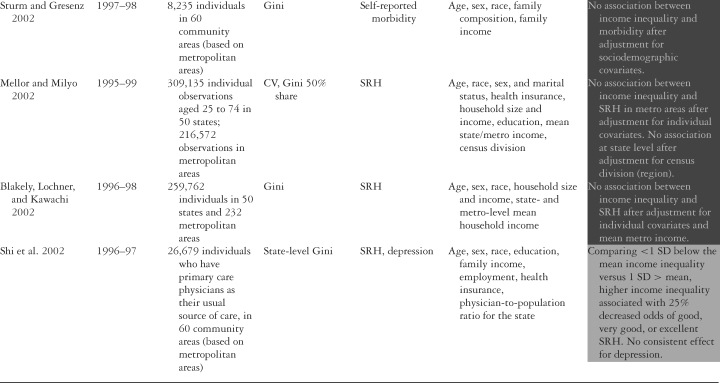
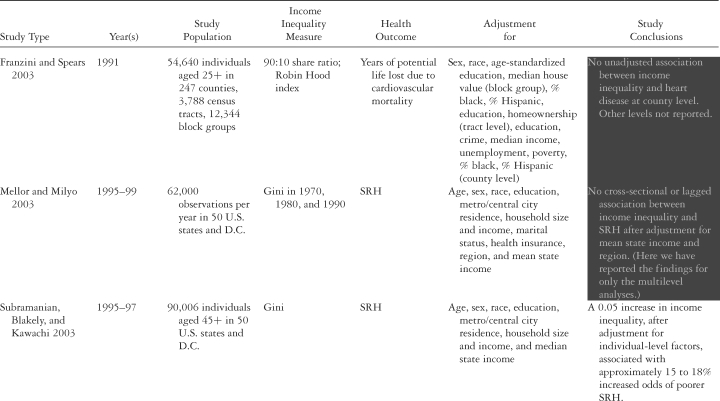

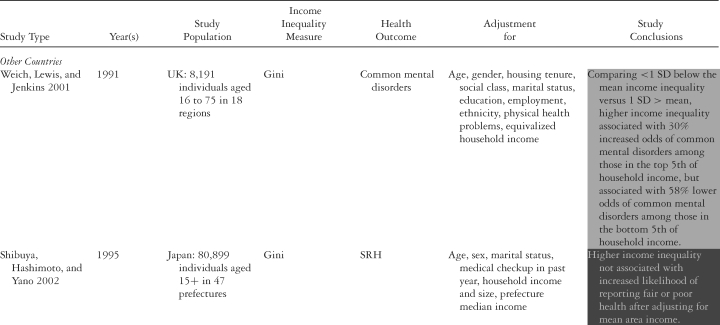
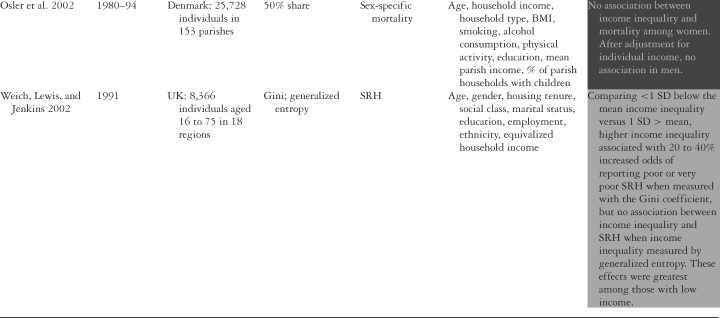
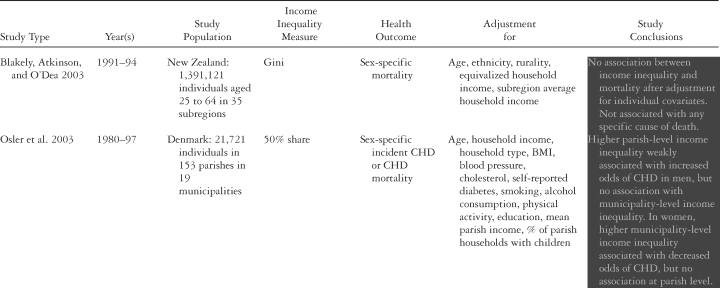
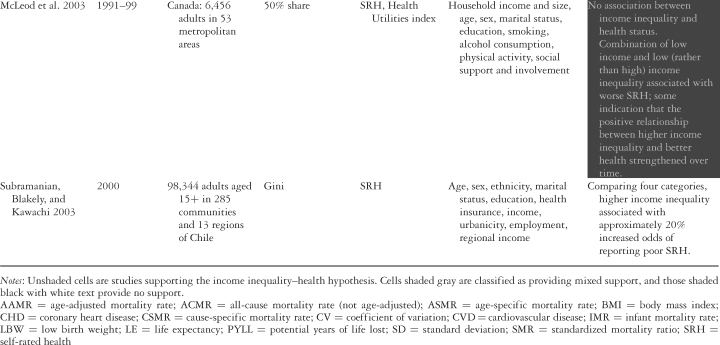
The studies in Table 2 that show no or negative associations are shaded black with white text. We characterized these studies as null findings because there was an association in the opposite direction to that hypothesized, no unadjusted association, or no association after adjusting for income, poverty, or some other set of covariates. Such adjusted null findings might mean that the association was not very robust and could be removed by one or two controls. The studies that we characterized as providing mixed evidence of links between income inequality and health are shaded gray. In these studies, the effects are specific to a subpopulation, outcome, or time period or are in some way more complicated to interpret (e.g., where effects are observed only in rural rather than urban counties or among blacks but not whites). Such judgments are, of course, arbitrary, but our intention was to show an overall pattern of evidence. Accordingly, readers may or may not agree with our characterization of studies showing mixed/limited support. Nevertheless, we described the conclusions of all studies, and readers can make up their own minds.
First, we sketch the basic findings of the review and then consider in more detail several themes that emerged.
International Studies
Aggregate-Level Studies
In the aggregate-level studies, countries are the units of analysis, and the purpose is to see whether differences in levels of income inequality help explain differences in some indicator of population health among countries. Note that several studies include both richer and poorer nations, thus complicating the task of deciding whether there is evidence for the original income inequality–health hypothesis (focused on richer nations). Of the 26 international aggregate studies, 15 support the income inequality hypothesis, six find no association, and another five offer mixed support. For instance, using 14 countries, Lobmayer and Wilkinson (2000) found that higher income inequality was associated with higher mortality among the young but with lower mortality in those persons over age 65. Thus we characterized this study as showing mixed evidence because these results would not be an a priori prediction of the original income inequality–health hypothesis and would be inconsistent with the stronger version of the psychosocial interpretation. Most of the studies with negative or mixed results were conducted after 1995, presumably using better-quality data. It is noteworthy that the studies by Judge (1995); Judge, Mulligan, and Benzeval (1998); Lynch and colleagues (2001); Gravelle, Wildman, and Sutton (2002); and Wildman, Gravelle, and Sutton (2003) specifically failed to replicate the previous positive findings of Wilkinson (1992), Rodgers (1979), and Waldmann (1992).
Multilevel Studies
Both the two international multilevel studies had null findings after controlling for within-country individual-level factors. Pampel's study (2002) did show a positive association between income inequality and average levels of smoking, but this effect was not robust and was eliminated when Greece was dropped from the analysis. Interestingly, this study showed how higher levels of income inequality were associated with weaker rather than stronger social gradients in smoking—the opposite of what might be predicted by the income inequality–health hypothesis. Rather, social inequalities in smoking were traced to the historical period when smoking became common throughout the population.
Within-Country Aggregate Studies
United States
Studies of the United States used the states, cities, counties, or some other level of aggregation as the unit of analysis and examined whether differences in income inequality among areas of the United States were associated with differences in the average health in these places. We identified 24 aggregate studies conducted within the United States. The nine studies between 1996 and 1999 were supportive. After 1999, four studies appeared that showed no association, and another nine showed mixed results. Studies showing no support generally had null findings after adjusting for some state characteristic such as education (Muller 2002) or, more controversially, the proportion of African Americans residing in the state (Deaton and Lubotsky 2003). The studies showing mixed evidence tend to be conducted at lower levels of aggregation, such as counties, and included apparently conflicting findings. In some of the studies, the associations were limited to nonmetropolitan counties (Brodish, Massing, and Tyroler 2000; Mclaughlin, Stokes, and Nonoyama 2001), but in another study, the associations were evident only in those counties with a population greater than 150,000 (Franzini, Ribble, and Spears 2001), which presumably are metropolitan counties. Nevertheless, the general impression from the within-U.S. aggregate studies is that there is a reasonably robust association between income inequality and some indicators of population health, such as mortality and homicide.
Canada and Europe
Of the eight aggregate studies conducted in Canada or among the richer nations of Europe, the effects of income inequality were evident in the United Kingdom (Stanistreet, Scott-Samuel, and Bellis 1999) and among 30 health districts of Saskatchewan (Veenstra 2002a), but not cross-sectionally (Ross et al. 2000b), in time-series analyses for Canada as a whole (Laporte and Ferguson 2003), or within coastal communities in British Columbia (Veenstra 2002b). Higher income inequality was associated with lower mortality in Belgium (Lorant et al. 2001) and, in 17 regions of Spain, was not associated with long-term disability (Regidor et al. 1997) or life expectancy after adjusting for average income (Regidor et al. 2003).
Other Countries
Of the five studies conducted in other countries, the evidence was either negative or mixed in Brazil (depending on the outcome and level of aggregation) (Szwarcwald, de Andrade, and Bastos 2002; Szwarcwald et al. 1999), but in Russian regions, the decline of life expectancy was linked to income inequality (Walberg et al. 1998). In Taiwan, links between income inequality and mortality of children under age five in 1995 that were not evident in earlier time periods were interpreted to mean that the associations had strengthened over time, but this effect was weaker for total mortality (Chiang 1999).
Within-Country Multilevel Studies
United States
We found 25 multilevel studies conducted in the United States. Of these, nine were supportive, eight were negative, and eight provided mixed support. The most consistently supportive evidence came from studies that measured income inequality at the state level (Subramanian, Blakely, and Kawachi 2003). When income inequality was defined at lower levels of aggregation, the evidence was less convincing. However, even the state-level studies were perhaps somewhat inconsistent. For instance, Kennedy and colleagues (1998) found that income inequality effects on self-rated health were concentrated among the poor, whereas Subramanian, Kawachi, and Kennedy (2001), using similar data and the same outcome, found no effects among lower-income groups. In contrast, Lochner and colleagues (2001) showed that the effects of state-level income inequality on mortality were strongest on the near-poor but were not evident among the poor or middle- or high-income groups.
Other Countries
Of the eight non-U.S. multilevel studies, seven were conducted in rich, industrialized nations. There was no evidence of a residual effect of income inequality on self-rated health in Japan (Shibuya, Hashimoto, and Yano 2002), on total mortality or ischemic heart disease (IHD) in Denmark, on self-rated health in Canada (McLeod et al. 2003), or on mortality in New Zealand (Blakely, Atkinson, and O'Dea 2003). There was mixed supportive evidence in two studies from the United Kingdom on self-rated health and mental disorder (Weich, Lewis, and Jenkins 2001, 2002). In contrast, a study in Chile showed greater income inequality associated with increased odds of poor self-rated health (Subramanian et al. 2003).
How Large Are the Direct Health Effects of Income Inequality?
Seventeen of the 25 U.S. multilevel studies provided at least some support for the IIH. Of the eight studies conducted in other countries, only three were in any way supportive. Thus, 20 multilevel studies offered at least some support for the IIH. Although some studies examined multiple outcomes, of the 20 supportive studies, 14 examined self-rated health, with other studies looking at mortality (two studies), risk factors (two studies), and the remainder analyzing depression, drug overdose fatality, morbidity, and common mental disorders (see Table 2). It is difficult to directly compare the effect sizes observed across the 14 supportive studies of the most common outcome—self-rated health—because the exposure contrasts differ. Some studies used categorical groupings of income inequality (Lochner et al. 2001); others used comparisons of standard deviation units (Shi and Starfield 2001); and still others used a 0.05 unit change in the Gini coefficient (Blakely et al. 2000; Subramanian, Blakely, and Kawachi 2003). The largest observed relative effect size was a 50 percent increased odds of poor self-rated health in a comparison of extreme quartiles of income inequality among working-age white men (Soobader and LeClere 1999). The smallest effect size was a 16 percent elevated odds of poor self-rated health for one standard deviation change in income inequality (Fiscella and Franks 2000). In other studies, more extreme exposure contrasts of at least two standard deviations in income inequality showed about 25 percent increased odds of poor self-rated health (Shi and Starfield 2001; Shi et al. 2002). In several studies, exposure contrasts of about five standard deviations in income inequality showed elevated odds of poor self-rated health ranging from 15 to 30 percent (Blakely et al. 2000; Subramanian, Blakely, and Kawachi 2003; Subramanian and Kawachi 2003). Thus the direct effects of income inequality on self-rated health were most often in the range of a 20 to 30 percent increase in risk. This supports the notion that the relative effects of income inequality are generally smaller than the relative health differences observed at the individual level between lower- and higher-income groups. In other words, relative health effects according to individual income are larger than the relative health effects of income inequality. This is to be expected and is commonly observed in multilevel studies of contextual health effects (Pickett and Pearl 2001). But a relatively modest contextual effect of income inequality may result in a high population burden of poor self-rated health (i.e., a large attributable fraction) if high income inequality applies to a large segment of the population.
Several issues in another, more recent, review of literature concerning income inequality and health (Macinko et al. 2003) distinguish it from ours. First, it contains fewer than half the studies reviewed here, although Macinko and colleagues were careful to point out their review was not intended to be systematic and covered only the period up to Januaury 2002. Furthermore, among the 47 studies is a literature review (Wagstaff and van Doorslaer 2000) and several studies using a health concentration index, which is a summary measure of income-related health inequality. Such measures may or may not reflect the extent of income inequality. But they are measures of socioeconomically patterned health inequality, and so it is difficult to interpret evidence from such studies in regard to the question we pose here about how income inequality affects levels of individual or population health. Although it is of interest whether income inequality affects the extent of health inequality, it is not germane to the original income inequality–health hypothesis. In addition, Macinko and colleagues included one study that used social capital as a measure of income inequality and one study that did not measure income inequality but, rather, variation in a summary deprivation score. Moreover, they counted the evidence from some studies more than once when repeating the same analysis in later studies. Unlike our review, they classified the study by Blakely, Lochner, and Kawachi (2002) as supportive, even though there was no effect of income inequality after controlling for household income. They also stated that some evidence supported the income inequality hypothesis from New Zealand. But the only published study from New Zealand of which we are aware found no evidence for an effect of income inequality on health (Blakely, Atkinson, and O'Dea 2003). In addition, Macinko and colleagues analyzed the support for the income inequality–health hypothesis based on the statistical significance of any result. This means that several studies we classified as having mixed findings, they classified as providing general support for the income inequality–health hypothesis. For instance, they stated that the study by Diez-Roux, Link, and Northridge (2000) found effects of income inequality on body mass index, hypertension, and sedantarism, when in fact the results differed by gender and outcome and therefore were more difficult to interpret.
Understanding the Evidence
International Comparisons
In 1995, Judge wrote a critique of the work linking income inequality with mortality, in which he pointed out that the analysis of the updated data added to the LIS database showed that Wilkinson's original findings could not be replicated. He argued that this “casts doubt on the hypothesis that inequalities in the distribution of income are closely associated with variations in average life expectancy at birth among the richest nations of the world” (Judge 1995, 1282). At least part of the discrepancy resulted from the fact that for some countries, particularly Germany, Wilkinson used an early release of the first wave of LIS data and not the later, updated version of the income data. These corrected data markedly changed Germany's income inequality rank (personal communication, Tim Smeeding, LIS director). In 1998, Judge and colleagues again found no association between income inequality and life expectancy (Judge, Mulligan, and Benzeval 1998). Income inequality was associated with infant mortality but not after controlling for female labor force participation, and they saw no association between the change in income inequality and the change in these outcomes.
It was in this context that we revisited the question of whether income inequality was associated with health differences among rich countries (Lynch et al. 2001) and conducted the widest-ranging international comparison (of rich countries) to date. We examined the associations between income inequality and low birth weight, life expectancy, self-rated health, and age- and cause-specific mortality in 16 countries providing data for the third wave of the LIS (1989–92). Our results demonstrated that when using more complete and updated income inequality data, there was little evidence for an association between income inequality and population health among rich nations, except for infant and child health outcomes, and even that was affected by excluding the United States. In discussing our results we argued that it was important to recognize the inherent limitations of interpreting associations based on 16, or fewer, observations. To illustrate this point, for Figure 5 we selected the same nine Organization for Economic Cooperation and Development (OECD) countries used by Wilkinson in his 1992 analysis that sparked so much interest in this topic. That study reported a correlation of r= 0.86 between more equal income distribution and life expectancy using data for the late 1970s and early 1980s. The figure shows that when we used these same nine countries but analyzed the data for 1989–92, higher income inequality was associated with lower life expectancy, albeit more weakly (r=−0.45) than in Wilkinson's original analysis.
Figure 5.
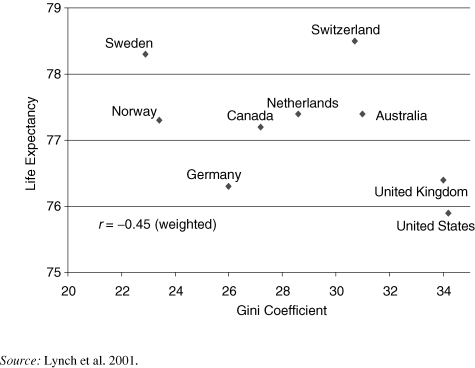
Income Inequality (1989–1992) and Life Expectancy at Birth (1991–1993) in the Same Nine Countries Used in Figure 4
As we noted earlier, the data available to Wilkinson in 1992 were incorrect—Germany implausibly had higher income inequality than the United States did. Compared with Wilkinson's plots, the relative position of Germany in our data from 1989–92 is very different, with lower levels of inequality relative to the United States and the United Kingdom. Direct comparisons are not possible because of the different measures (we used the Gini, and Wilkinson used the 70 percent income share). Nevertheless, if Germany were hypothetically given a Gini value for income inequality consistent with that assigned in Wilkinson's original analysis (i.e., at least as large as the U.S. Gini), the correlation between income inequality and life expectancy for the same set of countries would be approximately r=−0.70, which is considerably closer to the value reported in his original findings. Thus, if we limit the analysis to the same nine countries available to Wilkinson and use an inflated value for income inequality in Germany, we can almost exactly re-create his 1992 findings.
Now that data are also available for Italy, Spain, France, Belgium, Finland, Luxembourg, and Denmark, when these countries were added to the analysis, Figure 6 shows that there is no longer an association between income inequality and life expectancy (r=−0.09, p= 0.75). Thus the discrepancy between our results and Wilkinson's study was simply that we had the advantage of being able to include more countries.
Figure 6.

Income Inequality and Life Expectancy in the Full Sample of 16 Countries
The addition of Italy, Spain, France, Belgium, Finland, Luxembourg, and Denmark highlights the complexity of using meta-theories to explain variations in population health among rich nations (Davey Smith and Egger 1996). While not directly comparable to the current analyses, because they were based on within-country differences, Mackenbach and colleagues (1997) and Kunst and colleagues (1998) showed how deciphering variation in the extent of within-country socioeconomic health inequalities across Europe is complicated by between-country differences in the cause-of-death structure, particularly the north-south differences in ischemic heart disease (IHD) (Leon 1998). Three of the countries we added in Figure 6—France, Italy, and Spain—are typical of the southern European pattern: higher life expectancy due largely to lower IHD. The countries added from northern Europe—like Denmark and Finland—have lower income inequality but higher IHD rates and lower life expectancy. It is highly unlikely that this north-south IHD and life expectancy differences emerged between the late 1970s and 1990s. So if data from more countries had been available, it seems likely that Wilkinson's original study in 1992 would also have found little association between income inequality and life expectancy among these rich countries.
There seems to be some evidence for associations between income inequality and child health outcomes. Macinko, Shi, and Starfield (2004) showed associations between income inequality and infant mortality across 19 OECD nations. According to Lynch and colleagues (2001), higher income inequality was associated with higher infant mortality rates (IMR), low birth weight, and mortality among children of both sexes aged one to 14. For a country of such vast wealth, the United States has high levels of income inequality and poor health of children. Associations with infant and early-life mortality largely disappeared when we dropped the United States from our analyses, although an association with low birth weight remained (r = 0.53, p = 0.06), due to high levels of both income inequality and low birth weight in the United Kingdom. Judge and colleagues (1998) showed earlier that associations with IMR were eliminated after controlling for the proportion of women in the labor force. Lynch and colleagues (2001) found that associations with mortality in people over the age of 65 were the opposite of that predicted by the theory that higher income inequality is automatically bad for health, a finding corroborated by Lobmayer and Wilkinson (2000). These negative associations were largely driven by the fact that higher-inequality countries like the United States and France have relatively low mortality rates for persons over the age of 65, especially for IHD, compared with the rates in countries like Finland, Denmark, Luxembourg, and Germany.
Some of the strongest arguments supporting the theory that greater income inequality produces worse population health have come from analyses of homicide and violent crime (Hsieh and Pugh 1993). In some ways, homicide has been the quintessential example of a cause of death that is plausibly affected by the extent of income inequality in light of the breakdown of social cohesion and the negative emotions of distrust and hostility it is theorized to engender in individuals. Although Lynch and colleagues (2001) found income inequality to be reasonably strongly correlated with homicide, these associations were induced entirely by the U.S. data point. For instance, excluding the United States changed the correlation between income inequality and homicide from r= 0.65 (p= 0.01) to r=−0.15.
According to the psychosocial environment theory, income inequality is associated with health through two main pathways: health behaviors and stress. In this study, income inequality was associated with lung cancer, but only among women and it was not associated with cirrhosis—both outcomes with a clear behavioral component. Nor was income inequality associated with IHD or diabetes, outcomes linked to both behavior and psychoneuroendocrine stress mediation. Although it is not directly the topic of this article, we should note the other results regarding the effects of the psychosocial environment. We also examined how distrust, membership in an organization, volunteer work (all proposed as measures of social capital), and perceived control over one's life circumstances were associated with between-country variations in health. One of the most important pieces of empirical evidence supporting the idea that social capital is an important determinant of population health came from a study in the United States of 38 states (Kawachi et al. 1997). This cross-sectional study showed that levels of distrust and the extent of organizational membership mediated the within-country association between income inequality and mortality. Even though Lynch and colleagues (2001) used indicators of social capital almost identical to those used in the U.S. study, they failed to find any consistent associations with between-country differences in age- or cause-specific mortality. In fact, some of the strongest correlations observed in these data were associations among lower control, greater distrust, and lower IHD. These findings are the opposite of what the psychosocial interpretation would predict and what would be inferred from individual-level studies.
Since the publications by Judge, Mulligan, and Benzeval (1998) and Lynch and colleagues (2001), all but three international studies have shown null or mixed results. Conflicting evidence concerning age-specific patterns came from Lobmayer and Wilkinson (2000), whereas Ellison (2002) showed effects of income inequality on life expectancy that were stronger among less wealthy nations—the opposite of what the original income inequality hypothesis would predict. Macinko, Shi, and Starfield (2004) demonstrated how wage inequality was associated with infant death, and further supportive evidence came from one study of homicide, which, however, included both rich and poor countries (Lee and Bankston 1999). The other supportive study was conducted among eastern European countries and found associations between change in income inequality and change in life expectancy (Marmot and Bobak 2000), but it is not clear whether it controlled for per capita GDP. A multilevel study of eastern European countries (Bobak et al. 2000) discerned no effects on self-rated health after controlling for deprivation.
The Income Artifact
Any finding from an aggregate-level study that uses places and not individuals as the unit of analysis leaves open the possibility that if there are a disproportionate number of poor people living in high-inequality places, the individual-level relationship between income and mortality will be sufficient to produce an aggregate level correlation between income inequality and mortality (the AIH). In other words, the observed place-level relationship is a “statistical artefact” (Gravelle 1998) generated by cross-level confounding resulting from the concave positive association between individual income and health. As a general principle, this concern is legitimate, and a recent study by Laporte (2002) adds weight to this contention by disaggregating the income distribution and showing how apparent health effects of income inequality pick up mainly the effects of low absolute income.
The essence of Gravelle's argument is that we already have convincing evidence at the individual level for an income gradient in health. Statistically speaking, then, all that is needed to generate a population-level relationship between income inequality and mortality (by aggregating individuals into areas) is a concentration of poor households in unequal areas. As we pointed out earlier, this is not news to anyone working on income inequality and health, and was noted by Preston and Rodgers more than 20 years ago. It nevertheless helped focus a more critical stance toward the aggregate U.S. evidence for income inequality and health in regard to cross-level confounding.
Wolfson and colleagues (1999) used data simulation to show that Gravelle's argument may be limited. Although Gravelle's critique is logically correct, it is insufficient to account for what is observed empirically across the U.S. population. In essence, Gravelle's critique of the association between income inequality and mortality is based on the fact that the individual-level relationship between income and mortality is nonlinear. For example, Figure 7 shows a clear nonlinear relationship between the risk of dying and household income. We estimated this relationship from data on household income and other demographic characteristics from the U.S. Census Bureau's Current Population Survey matched to the National Death Index, providing about 7.6 million person-years of mortality exposure from ten years of follow-up. The population density curve shows how many individuals were at each income level. The characteristic shape indicates that because of the long upper tail of the distribution, more than half the population have incomes below the mean.
Figure 7.
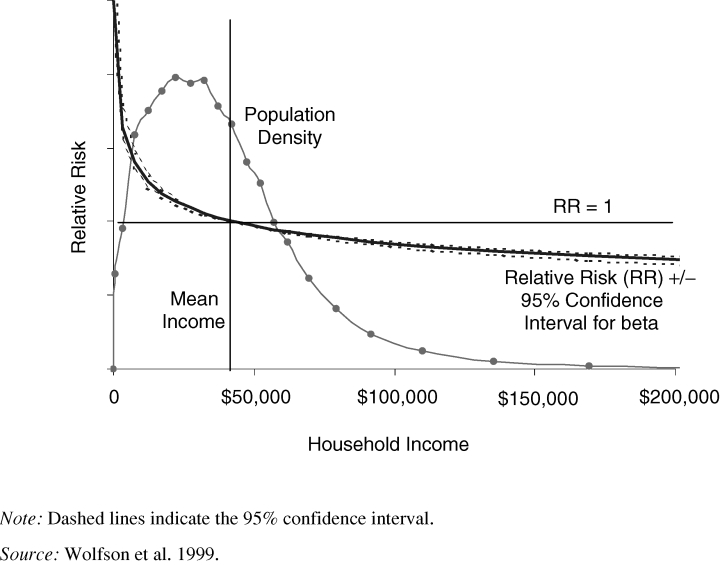
Relative Risk of Dying and Population Distribution for U.S. Individuals by Household Income
Figure 8 illustrates Gravelle's critique in a very simple case of two societies, A and B, each with two members. Society A is highly unequal, with member 1 having a very low income (Y1A) and member 2 having a very high income (Y2A). In contrast, the incomes of members 1 and 2 in society B (Y1B and Y2B, respectively) are much closer together; hence their income is more equally distributed. (By design, both societies have the same average income in order to make the basic issue as clear as possible.) We assume, however, that no matter how income is distributed in a society, at the individual level the same relationship between the risk of dying and income applies, as shown by the downward-sloping curve, with a shape similar to that observed for the United States in Figure 7.
Figure 8.
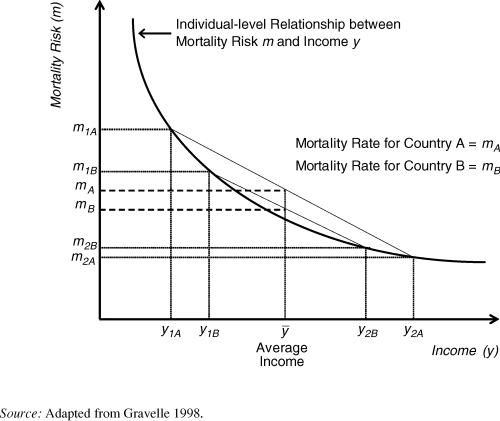
Income and Mortality in a Pair of Hypothetical Societies
The vertical locations of MA and MB along this relative risk curve are simply the average mortality rates of the two societies. Clearly, MA is higher than MB, so that the more unequal society A would be observed to have a higher mortality rate. The important point is that this aggregate observation has nothing at all to do with the health effects of income inequality per se. Rather, it is simply the result of the curvilinear relationship between income and mortality operating at the individual level.
The dashed lines in Figure 9 show a simple linear regression for the hypothetical mortality rates, and the solid line is a fit to the actual data. The dashed line has a clear slope, so Gravelle is certainly correct: Income inequality combined with a curvilinear relationship at the individual level between income and mortality risk can indeed account for an observed relationship at the aggregate level between inequality and mortality. But it is also clear from these graphs that the slope of the dashed line is not as steep as the slope of the observed relationship. Therefore, it seems that something may be going on over and above the statistical artifact in this relationship among U.S. states.
Figure 9.
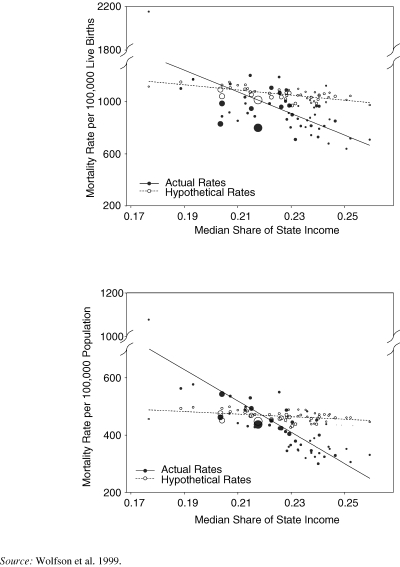
Scatter Plots of Hypothetical and Actual Mortality Rates for Infants and Working-Age Males by Income Inequality, U.S. States, 1990
This general conclusion is supported by the multilevel U.S. studies. Virtually all the U.S. multilevel studies controlled for some measure of individual or household income (see Table 2), and while not all survived this test, most found that individual income does not remove the effects of income inequality. This clearly is dependent on how well income is measured and whether its functional form can be specified to fully capture low absolute income (Laporte 2002).
Comparing the United States and Canada
Until 1999 the main empirical observations supporting an association between income inequality and health were Wilkinson's between-country analyses and the aggregate-level studies of U.S. states. Given the cultural and economic similarities, a cross-border comparison of Canada and the United States offered a potentially informative lens to determine whether income inequality more generally affected population health. Ross and colleagues (2000b) compared the association—using virtually identical data definitions—in U.S. states and metropolitan areas and across Canadian provinces and cities. These comparisons confirmed the strong association across states and metropolitan areas in the United States but found no association between income inequality and mortality in Canada. Initially, this was viewed as the “Canada paradox.” But several lines of evidence now suggest that there is little or no association in other wealthy countries. An unpublished international comparative analysis (Figure 10) further showed an aggregate association across cities in the United States and Great Britain, but not in Canada, Sweden, or Australia (Ross et al. 2002). This is interpreted to mean that there is a threshold above which income inequality affects population health.
Figure 10.

Working-Age Mortality by Median Share of Income in 528 Metropolitan Areas in Five Countries, 1990–1991: United States, United Kingdom, Canada, Sweden, and Australia
The evidence in Figure 10 that there is an association between income inequality and mortality in the United States and the United Kingdom but not in Canada, Sweden, or Australia has prompted several new lines of research, as well as challenges to the results. It is possible that the Canadian data did not have the statistical power to reveal an association even if there was one. However, if we consider only this subset of U.S. cities with income inequality measures in the same low range as those of the Canadian cities, a significant negative slope remains for the U.S. metropolitan areas (Figure 11), whereas as before, there is no relationship for Canadian cities (Ross et al. 2000a). The evidence therefore suggests real differences in this relationship between Canada and the United States.
Figure 11.
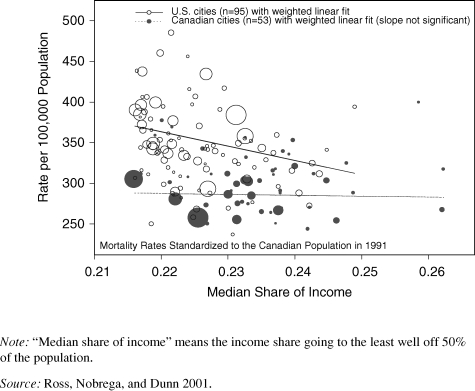
Comparison of U.S. and Canadian Cities over Canadian Range of Income Inequality
This aggregate evidence provides no guidance on why the United States and the United Kingdom seem to differ from these other wealthy countries. The use of aggregate income inequality data does not imply that the distribution of household money income is the underlying factor that should be the focus of attention in trying to understand the observed associations. Rather, income and its distribution may just as well be a marker for a complex of other, more deeply rooted factors relating to the extent and character of social inequality in these countries. For example, some aspects of basic social values involving intolerance of inequality and greater trust in government may be responsible for the differences among such countries as Canada, Sweden, Denmark, and Australia, on the one hand, and the United States and the United Kingdom, on the other. Widespread trust in government, which is higher in countries like Canada and Sweden than in the United States (Alesina and La Ferrara 2002), is itself the result of social processes, such as investments in schooling and health care and welfare services more generally. Thus, trust in government may be seen as a marker for a history of structural social investments, laws, and public policies that are transparently intended and are understood by the population as attempts to improve the life circumstances of most people (Muntaner et al. 2002; Navarro and Shi 2001). In fact, Lynch and colleagues (2001) showed that those countries with the highest levels of overall trust are the Nordic social democratic welfare states, where equitable social investments have been at the core of public policy for decades and, in some places, for more than a century (Kautto et al. 2001). Nevertheless, a measure of generalized distrust was not associated with differences in life expectancy among these rich countries (Lynch et al. 2001).
Several lines of investigation are continuing to try to better understand why the link between income inequality and health appears not to exist in Canada. These include the following:
Income definitions and the nature of the labor market. In the United States, household income may be a better marker for labor market income, whereas in Canada, with its more substantial tax/transfer system, household income may be too “blurred” to show such a relationship. A recent analysis of multiple concepts of income, income inequality, and working-age mortality among U.S. and Canadian metropolitan areas sheds some light on the effect of labor market inequality on the health of Canadians (Sanmartin et al. 2003). These analyses reveal differences among aspects of labor market participation. For instance, Canada and the United States show different patterns of linkages between unemployment and income inequality and also different associations with mortality. In Canada, unemployment appears more strongly linked with mortality, while in the United States, it is income inequality.
Universal health care. Canada has a universal health care system, whereas in the United States, access to health care is significantly limited at the lower end of the socioeconomic spectrum.
Taxation and social policy. Any health effects of the unequal distribution of incomes generated by the market are blunted by redistributive and other social policies that buffer the effects of market-driven inequality by providing a more complete infrastructure that supports the most disadvantaged and hence leads to better overall population health (Sanmartin et al. 2003).
Character of the places in which people live. U.S. cities have much more spatially concentrated areas of affluence and poverty than Canadian cities do, with their attendant differing availability of public goods and urban amenities. These could be important underlying differences between Canada and the United States (Dunn and Hayes 1999, 2000; Ross, Nobrega, and Dunn 2001).
The null findings in Canada are important because they demonstrate that although a strong relationship between income inequality and mortality is certainly possible, the existence of such a relationship is not universal. This conclusion also has implications for how any observed link between income inequality and health might be interpreted. The fact that income inequality is associated with mortality in the United States and United Kingdom, but not in Canada and other rich countries, challenges the strong version of the psychosocial interpretation. It would be hard to argue that Canadians perceive their relative disadvantage differently from their neighbors to the south, unless we contend that Canadians are not aware of, or are unconcerned about, their relative deprivation. It is much more plausible that social investments in people, places, and resources for health have broken the link—especially with regard to socioeconomic conditions for the most disadvantaged—between income inequality and health, which appears to exist in the United States and perhaps the United Kingdom. The lack of association between income inequality and health in Canada suggests that something implicit in Canada's social structure buffers any adverse health effects of income inequality that have been observed in the United States. The same may be true for differences between the United States and United Kingdom, and Canada, Sweden, Denmark, New Zealand, Australia, and other rich nations.
American Exceptionalism
The fact that rigorous comparisons of the United States and Canada show no association in Canada suggests that far from its being a story about the “Canadian paradox,” it appears that the real story may be one of “American exceptionalism” (Muntaner 1999). In 1996, in the first study of U.S. states, higher income inequality was associated with a more unequal distribution of many potential determinants of health. The Canadian results show that there appears to be no necessary association between income inequality and population health. Rather, it may depend on the social distribution of other health-relevant resources and exposures in a country or region and on the direct socioeconomic support of the most disadvantaged.
The social distribution of risk factors for specific outcomes is important in this regard. If income inequality is not correlated with the social distribution of major risk factors, then it is unlikely to be linked with population health. For example, at the population level, southern Europe has low levels of and low social inequality in IHD (Kunst et al. 1998). This may be related to historical and cultural influences affecting the social distribution of healthy “Mediterranean diets.” Southern European countries such as Spain and Italy, depending on the particular constituents in the diet, reveal smaller, nonexistent, or even reverse socioeconomic differences in aspects of health-enhancing diets (González et al. 2002). For instance, the total consumption of fat, especially from animal sources, and cholesterol are lower among the less educated in northern Italy (D'Amicis, Faggiano, and Saba 1994; Palli, Decarli, and Russo 1999). In northern European countries, where IHD and social inequalities in IHD are higher and more healthy diets are much more common among the better educated and affluent, cholesterol and fat consumption show the opposite pattern (Lynch, Kaplan, and Salonen 1997; Pekkanen et al. 1995; Roos et al. 2001). So in southern Europe at the individual level, lower income is less a barrier to eating a healthy diet. In the United States, United Kingdom, or other countries with different food traditions, income and education are more closely linked to more healthy diets (Diez-Roux et al. 1999; Popkin, Siega-Riz, and Haines 1996). In some countries, strong cultural traditions may supplant the socioeconomic factors that often determine the access to and consumption of a healthy diet in other contexts. There is some evidence that in countries like the United States and United Kingdom, low income can present even greater barriers to healthy eating, partly because of the lack of access to and the higher relative cost of healthy diets and the lower relative cost of less healthy food. There is evidence from the United States (Morland et al. 2002) and Scotland (Ellaway and Macintyre 2000; Sooman, Macintyre, and Anderson 1993) that because of unequal geographic distribution, poorer people have fewer choices, receive poorer quality, and spend a larger relative share of their incomes on healthy food such as fresh fruit and vegetables. However, in some places this situation may be changing, and questions have been raised about the existence of “food deserts” in the United Kingdom (Cummins and Macintyre 2002). Nevertheless, in some circumstances, a low income can purchase fewer health resources than does a comparably low income in an environment where the consumption of healthy food is culturally consistent and common. In this example, higher income inequality may not be linked to IHD because it does not affect the broad social distribution of healthy food.
Another example is the relatively low life expectancy of Danish women, which probably is related to the high prevalence and low social inequality of smoking (Cavelaars et al. 2000). Even though Denmark has low levels of income inequality, this has not automatically improved the health of Danish women. For other cultural reasons, an egalitarian social diffusion of smoking among women has helped generate both low socioeconomic inequality in smoking and the lowest female life expectancy in western Europe, although this situation is beginning to improve. Aggregate indicators such as income inequality are linked to health when they influence the social distribution of the risk factors for particular outcomes, but this social distribution is also influenced by factors other than income inequality. These two examples of diet in a high-income inequality environment in southern Europe and smoking in a low-income inequality environment in northern Europe demonstrate that income inequality does not necessarily drive the levels or social distribution of major disease risk factors. Understanding the processes through which different countries generate overall and cause-specific levels of population health and their social distribution is therefore historically and culturally contextualized (Davey Smith and Egger 1996; Krieger 2001; Leon 2001). As Kunitz argued, there often is a need for “particularism” in order to understand the social determinants of population health and health inequalities (Kunitz 1990, 1994).
It may not be income inequality per se or the quality of the psychosocial environment that drives population health. Rather, what may be most important is the current and historical links between income inequality and the levels and social distribution of health-relevant resources and exposures and how these have played out over the lifecourse of different birth cohorts (Davey Smith, Gunnell, and Ben-Shlomo 2001; Davey Smith and Lynch 2004). During World War II in Britain, both income inequality and noncombat mortality rates fell (Wilkinson 1986). This may, however, have had more to do with the fact that food rationing evened out the social distribution of a healthy diet, especially for disadvantaged pregnant women and children (Winter 1988) than with improvements in the psychosocial environment. In countries like Sweden and Canada, adverse changes in income inequality are less closely linked to adverse changes in social policy regarding maternal and child health (Vleminckx and Smeeding 2001), education, access to health care, or workplace and environmental health regulation than they are in the United States. This phenomenon cannot be understood, however, without considering the historical context for the emergence of and broad-based sociopolitical support for such policies during the 20th century (Coburn 2000; Navarro and Shi 2001), and how the values embodied in these policies reflect the broader social solidarity embedded in strong bridging and linking social capital (Szreter 2002b). Levels of health within a country are the product of complex interactions of history, culture, politics, economics, and the status of women and minorities and may not be adequately described by current levels of income inequality or aggregate indicators of the psychosocial environment (Kunitz 2001).
The negative results for rich countries like Australia, Canada, Sweden (Ross et al. 2002), Denmark (Osler et al. 2002), Japan (Shibuya, Hashimoto, and Yano 2002), and New Zealand (Blakely, Atkinson, and O'Dea 2003) point to the conclusion that only within the United States does there seem to be a relationship between income inequality and health. As the results of some studies show (Ross et al. 2002; Stanistreet, Scott-Samuel, and Bellis 1999; Weich, Lewis, and Jenkins 2001, 2002), the United Kingdom may need to be added, but here we will defer discussion of the United Kingdom and focus on the much more widely studied U.S. situation. Kawachi and Kennedy (2002) have convincingly demonstrated that there is apparently something rather different about the way income inequality is manifested in the United States, suggesting we may need to understand more about the economic, social, political, and spatial correlates of U.S.-style income inequality.
Interpreting Associations within the United States
The most important step in gathering stronger evidence concerning the potential health effects of income inequality is to make empirically explicit the notion that health is a function of both individual characteristics and environmental features (Wagstaff and van Doorslaer 2000). Multilevel statistical techniques allow for the simultaneous modeling of exposures at both the individual and aggregate levels. Their purpose is to tease out the net effects on health of area-level income inequality while controlling for relevant characteristics of the individuals residing in those areas (e.g., compositional differences in age, income, education, etc.) and for other potentially confounding contextual characteristics of areas that might be associated with both income inequality and health (e.g., other place-level characteristics, such as access to health care).
As we already have noted, the most persuasive evidence in favor of the IIH seems to come from the U.S. studies. All eight multilevel studies classified as null findings in Table 2 measured income inequality at levels of aggregation below those of the U.S. states, except the studies by Mellor and Milyo (2001, 2003), which we discuss later. In one study of Texas counties, block groups, and tracts, no unadjusted association was discovered between income inequality and cardiovascular disease (CVD) (Franzini and Spears 2003). Studies examining mortality by Fiscella and Franks (1997) at the county level, and morbidity by Sturm and Gresenz (2002) at the metropolitan-area level, found no association after adjusting for individual covariates. Blakely, Lochner, and Kawachi (2002) did find an effect of income inequality on self-rated health after adjusting for individual covariates, which disappeared after adjusting for mean metropolitan-area income, and one study of Chicago neighborhoods actually found higher income inequality associated with better self-rated health (Wen, Browning, and Cagney 2003). Of the 17 multilevel U.S. studies providing some support for the income inequality–health hypothesis, 11 used state-level measures of income inequality, and thus there seems to be some consensus that the U.S. states are the empirically relevant level at which to measure income inequality (Subramanian, Blakely, and Kawachi 2003; Wagstaff and van Doorslaer 2000).
The first two U.S. studies of states, both published in 1996, were the first within-country studies to corroborate Wilkinson's international findings (Kaplan et al. 1996; Kennedy, Kawachi, and Prothrow-Stith 1996). Kaplan and colleagues (1996) showed that in 1980 and 1990, the income share held by the least well off 50 percent of the population in each state was cross-sectionally associated with overall mortality plus a variety of other health outcomes. Kennedy, Kawachi, and Prothrow-Stith (1996) used the Gini and “Robin Hood index” and showed them to be strongly related to infant mortality, coronary heart disease, malignant neoplasms, and homicide. These studies demonstrated that associations were not affected by adjustment for median state income or poverty levels, were observed for almost all percentile shares of the income distribution, were consistent across age groups, and were found for both black and white mortality and in both sexes. The study by Kaplan and colleagues is especially important here because it demonstrated that income inequality was strongly associated with a number of other social and educational characteristics of U.S. states. These were postulated as “potential pathways” between income inequality and health. They revealed that income inequality was associated with higher unemployment and work disability, lower health insurance coverage, social welfare, educational achievement, educational and medical expenditure, and even fewer library books per capita.
It often is difficult in observational studies to decide which factors should be considered confounders and which should be considered in the causal pathway between exposure and outcome. One place to start is with clearly specified, temporal causal models that can guide empirical analysis, but even then our inability to reliably and statistically adjudicate intermediary from confounding variables makes this task difficult. Thus, we are left with arguments about the over- and underadjustment of potential confounders, with no clear way to resolve them other than to resort to an a priori conceptual causal model, which often is not explicitly stated or shared by all researchers. Nevertheless, it may be informative concerning the robustness of effects whether adjusting for one or two controls for other aggregate-level characteristics can remove the association between income inequality and health.
Some of the most important challenges in this regard concern studies that have removed the aggregate effects of income inequality on health after controlling for state-level education (Muller 2002), U.S. Census region (Mellor and Milyo 2002, 2003), and the proportion of African Americans residing in the area (Deaton and Lubotsky 2003). In an aggregate analysis of U.S. states, Muller (2002) showed that controlling for “percent without a high school diploma” removed the association between income inequality and mortality. Mackenbach (2002) commented that it is difficult to decide whether aggregate differences in education should be considered a confounder or an intermediary. Kawachi and colleagues (Blakely and Kawachi 2002; Kawachi et al. 1997) argued that adjusting for aggregate education in links among income inequality, social capital, and mortality may be an inappropriate overadjustment. On the one hand, this is reasonable, for higher income inequality may affect current levels of equitable investments in education. Although this probably is true, how do current levels of income inequality affect education and then mortality? If income inequality influences the current distribution of educational resources, these effects are felt by those currently and soon-to-be in the education system. Aggregate indicators of educational achievement measured cross-sectionally from the census summarize the differential educational experiences of the whole population, constituted by multiple birth cohorts. How do we align this with the fact that mortality statistics are dominated by deaths among middle and older ages, who were educated 40 to 50 years earlier than when they appear in mortality statistics? Current income inequality and its consequent effects on educational resources cannot affect their educational levels.
The overadjustment argument may be clearer in a lifecourse perspective. At the individual level, education generally comes before income, and education serves at least in part as a marker of early-life social conditions (Davey Smith et al. 1998). Furthermore, there is evidence that education and later-life socioeconomic markers such as income or occupation can have independent effects on a variety of health outcomes (Backlund, Sorlie, and Johnson 1999; Beebe-Dimmer et al. 2004). In individual-level studies, education (because it comes before income) can reasonably be conceptualized as a confounder of the association between adult income and health. At the population level, given the importance of education to earnings inequality (Levy and Murnane 1992), we could also argue that historical investments in education may affect subsequent distributions of income. There is evidence that the U.S. regions with the highest levels of income inequality in 1990—the Northeast and the South—provided weaker support for higher education in the early 20th century (Goldin and Katz 1998, 1999). Thus we could hypothesize that those places with historically higher average levels of education may be more likely, 20 to 50 years later, to have a better educated workforce that can generate higher average income levels and possibly secure more equal distributions of income. The reason is that for individuals, one of the main inputs into income-generating potential is education. These issues require empirical investigations of time-lagged effects of historical levels of education on current health (Lynch, Harper, and Davey Smith 2003).
In two multilevel analyses, Mellor and Milyo (2002, 2003) showed that controlling for U.S. Census region negated the correlation between state-level income inequality and self-rated health. They argued that “it is crucial to control for such factors since important determinants of both health outcomes and income inequality vary across regions of the United States” (Mellor and Milyo 2003, 147). In an attempt to clarify this issue of regional factors, Subramanian, Blakely, and Kawachi (2003) examined the same data but used different modeling strategies. Although they reached opposite conclusions, a case could be made that both were correct because they were asking somewhat different questions. Mellor and Milyo's interest was in the robustness of the association of income inequality with health. They wanted to know whether income inequality had an effect after controlling for unmeasured regional differences, so they used a fixed-effects model with regional dummy variables to arrive at a negative answer. This analysis shed no light, however, on what those unmeasured regional characteristics might be. Subramanian and colleagues had a different approach. After accounting for the geographic clustering of individuals in states and regions, they wondered whether income inequality had an effect on self-rated health. Therefore they set out to investigate, rather than adjust for, between-region variation. They used a fixed- and random-effects model that accounted for regional and state clustering of individuals and concluded that income inequality was important to understanding the area variation in individuals’ self-rated health. In sum, Mellor and Milyo did show that income inequality effects do not stand up to regional control, but we are left with a “black box” of what those regional factors might be. We do know that they wipe out the effect of income inequality. In contrast, Subramanian and colleagues demonstrated that after controlling for geographical clustering in regions and individual compositional differences, income inequality was associated with state-level differences in self-rated health, but they did not include the unmeasured factors captured in the dummy variables used by Mellor and Milyo.
The most controversial challenge came from Angus Deaton, who claimed that “in the U.S., the relationship between income inequality and mortality is a mask for the effects of race; whites die younger in cities and states where there is a larger fraction of the population that is black” (Deaton 2002, 548). Mellor and Milyo (2001) reported a similar result in an earlier aggregate analysis of the U.S. states and found no effect of income inequality on mortality, except for homicide, after controlling for the proportion of black residents. As Deaton and Lubotsky explained:
This divergent behavior of black and white incomes means that the income difference between blacks and whites is larger in cities with larger black populations, which is what induces the relationship between overall income inequality and racial composition. Of course, this does not[italics in the original] mean that racial composition and income inequality are the same thing, nor that either is an equally valid marker for the same underlying health risk.
(Deaton and Lubotsky 2003, 1145)
In a response, Subramanian and Kawachi argued that “in other words, it has been claimed that the effect of ‘percent black’ trumps the effects of state income inequality on health, and that the real culprit behind poor health achievement is racial heterogeneity, not income inequality per se” (Subramanian and Kawachi 2003, 1023). Deaton and colleagues used individual and aggregate data for the U.S. states and aggregate data for the U.S. states and cities to demonstrate that there was no effect of income inequality on mortality risk after controlling for the proportion of African Americans living in the area. In their response, Subramanian and Kawachi used a multilevel analysis of census and Current Population Survey data to show that there is an effect of state-level income inequality on self-rated poor health after adjusting for percent black and an extensive array of other individual-level covariates, including race, education, income, health insurance, and employment status. In other words, they found the opposite of what Deaton and colleagues did: that racial heterogeneity (as measured by percent black) does not trump the effects of income inequality on self-ratings of poor health. Subramanian and Kawachi concluded that their results, “at least in the case of the U.S., may settle some of the current disputes” (Subramanian and Kawachi 2003, 1027).
These studies are impossible to compare directly because they differ in regard to the outcome, data set, and modeling strategy, which Subramanian and Kawachi acknowledge in their paper. An important issue here concerns the imprecise use of the word health, not just in the literature related to income inequality, but in the social determinants field in general. Deaton studied mortality and Subramanian and Kawachi studied self-rated health. The usual approach—which Subramanian and Kawachi followed—for justifying the use of self-rated health as a valid outcome is to cite studies (Benyamini and Idler 1999; Idler and Benyamini 1997) showing that self-rated health is a strong predictor of mortality. Seen in this light, Subramanian and Kawachi's claim that their analysis settles the dispute relies on the assumption that mortality and self-rated poor health are reasonably interchangeable as outcomes in regard to the mechanisms that might link them to income inequality. There are several reasons, however, to be cautious in making this transposition (Lynch, Harper, and Davey Smith 2003).
Relevant here are unpublished analyses from the National Longitudinal Mortality Study, which used more sophisticated and powerful modeling techniques showing an independent effect of income inequality on mortality, but only among men aged 25 to 64, after controlling for individual characteristics like income, education, unemployment, and race (Backlund et al. 2003). Conversely, there is some evidence that higher income inequality is weakly associated with lower mortality risk among those persons over age 65. These analyses also show an effect of income inequality on working-age male mortality after controlling for the state's racial composition, so while income inequality and race are highly correlated across U.S. states, there does appear to be some residual effect of inequality on mortality of working-age males. After these extensive controls, the mortality effect of income inequality is, not surprisingly, modest, but it does show that under certain social, economic, political, cultural, and historical circumstances, income inequality may influence mortality in some age-sex groups, even after extensively controlling for compositional characteristics and the proportion of African Americans residing in the state.
The studies we have discussed highlight the difficulty of disentangling one contextual characteristic from another. We know that aggregate-level indicators derived from the U.S. Census can be highly correlated (Geronimus and Bound 1998; Krieger et al. 2002) and present empirical challenges in trying to disentangle their separate effects. Mellor and Milyo (2003) used regional dummies that captured many differences—historical and contemporary—among U.S. regions. Similarly, Muller's use of education undoubtedly captures other information about U.S. states besides education (Muller 2002). The use of “percent black” by Mellor and Milyo (2002) and Deaton and Lubotsky (2003) is especially difficult to interpret because of the unique social meaning of this variable in the United States. The geographic distribution of African Americans in the United States reflects historical and social forces reaching back to the time of slavery. That places with higher concentrations of racial/ethnic minorities generate, in some way, worse health for everyone is not a observation (Massey, Condran, and Denton 1987). In 1950, Alfred Yankauer showed that infant mortality was higher for whites and nonwhites in those areas of New York City with higher proportions of births to nonwhites (Yankauer 1950). Deaton and Lubotsky's aggregate analysis (2003) rejected health services, education, and regional differences as explanations for the effect of race/ethnic composition. Instead, they endorsed the direct psychosocial/social capital explanation, that the physical presence of greater concentrations of nonwhite race/ethnic groups reduces trust within the community and induces stress among whites that affects their mortality. The proportion of blacks in a state is correlated with many other factors. In a highly racialized society such as the United States, places with more minorities may tend to underinvest across a broad spectrum of infrastructure that may influence health for everyone via the “spillover effects” of institutionalized racial discrimination. Even a cursory examination of the contemporary U.S. Census shows that those states with higher proportions of blacks have adverse conditions affecting whites as well, including greater overall poverty, lower average incomes, smaller monthly welfare support payments (but not welfare caseloads), more women without Medicaid insurance, fewer homeowners, less health insurance coverage, more female single-headed households, and lower educational attainment. Detailing these correlations does not help us understand what the variable “percent black” stands for, but it does suggest caution for causal interpretations. Indeed, this list is not unlike the social correlates of income inequality. So it is not clear what causal insight is gained in the shift from saying that income inequality affects health to saying that the proportion of black residents affects health when both are linked to a complex array of other historical and contemporary social factors.
Specificity of Associations and Time Lags
In the literature on income inequality and health, for both pragmatic (data availability) and conceptual reasons, there have been few studies designed to test outcome-specific associations. Although it is important to establish associations with overall health indicators, etiological studies of the social determinants of health may be most informative when examining more, rather than less, specific outcomes (Lynch and Davey Smith 2003). Different health outcomes may have distinct pathophysiological and behavioral pathways, so the main mechanism through which a particular social factor—like income inequality—may be linked to heart disease is likely to be different from the mechanism through which it may be linked to infant mortality or homicide. These different mechanisms may also imply different etiological time lags between exposure and outcome. This potentially important mechanistic specificity can be masked by examining general outcomes such as all-cause mortality, life expectancy, or self-rated health. General outcomes have multiple potential pathways, so that self-ratings of poor health, for example, can be generated by a variety of mechanisms (e.g., physical disability, poor mental health, presence of specific chronic diseases) that may differ further by age and gender. Conceptualizations of age- and cause-specific etiology have received little attention in discussions of associations between income inequality and health. This perhaps reflects the fact that they are rarely considered in the health inequalities field in general.
As we noted at the outset of this article, the mindset has been to highlight the consistency of associations across different outcomes, times, and places. In this view, the outcome does not matter all that much; the important fact is that associations are consistent across different socioeconomic indicators. This conclusion has led to ideas that socioeconomic conditions are “fundamental” causes of ill health (Link and Phelan 1995). And in one sense, they are fundamental causes because socioeconomic conditions generally and strongly influence the distribution of exposure and susceptibility. But this says nothing about which specific exposures, susceptibilities, and hence outcomes are involved. In other words, there are no fundamental mechanisms linking social disadvantage to different sorts of health outcomes, although it is possible that stress-mediated processes are mechanisms for general susceptibility to some health outcomes. At one time, smoking was more common among the rich, whereas now, in most rich countries, it is more common among the poor. The specific mechanisms through which socioeconomic disadvantages are expressed in health may differ across context and time. Accordingly, there has been less recognition of negative findings, heterogeneity of the strength of associations, or attention to understanding how different markers of social position might be linked to different outcomes in different ways at different times. For instance, Davey Smith and colleagues (2003), Howard and colleagues (2000), and Wong and colleagues (2002) offer insightful demonstrations of the heterogeneity of associations between race/ethnicity and cause-specific mortality. These studies underscore the need to consider how a particular marker of social position is linked to different outcomes.
Most of the international studies of income inequality and health used general indicators such as life expectancy and all-cause mortality. As we stated, there is little evidence for an association between income inequality and these outcomes. Several studies, however, also used infant mortality as an indicator of population health and found somewhat more evidence in favor of an adverse effect of income inequality, especially among richer countries (Lynch et al. 2001). But it is not clear whether these effects can stand up to controls for such things as female labor force participation (Judge, Mulligan, and Benzeval 1998). Lobmayer and Wilkinson also demonstrated strong effects of income inequality on mortality at younger ages (Lobmayer and Wilkinson 2000). So, even though no overall link was discovered between income inequality and general population health indicators in the international evidence, there may be some evidence of its effects on infant and child mortality, and homicide—outcomes implying somewhat shorter time lags. A limitation of most of these studies is that they are attempting to explain the effects of income inequality on mortality, not on other important population health outcomes such as morbidity or mental health. The fact that income inequality does not have a universal effect on mortality in rich countries does not preclude the possibility that higher levels of income inequality may universally and adversely affect quality of life, causing human suffering and misery (Lynch and Davey Smith 2002). But such investigations are severely hampered by the lack of internationally comparable data (Kessler 2000; WHO 2000) that make international comparisons of outcomes such as self-rated health difficult to interpret (Bobak et al. 2000; Lynch et al. 2001).
Some within-country studies have examined more specific health outcomes, including infant mortality (Kennedy, Kawachi, and Prothrow-Stith 1996; Shi et al. 1999; Sohler et al. 2002; Szwarcwald, de Andrade, and Bastos 2002); low birth weight (Kaplan et al. 1996); homicide (Daly, Wilson, and Vasdev 2001; Kennedy et al. 1998; Szwarcwald et al. 1999; Wilkinson, Kawachi, and Kennedy 1998; Wilson and Daly 1997); and different causes of death such as heart disease and stroke (Franzini and Spears 2003; Kennedy, Kawachi, and Prothrow-Stith 1996; Osler et al. 2003; Shi et al. 2003); as well as sexually transmitted disease (Holtgrave and Crosby 2003), depressive symptoms (Fiscella and Franks 2000; Henderson et al. 2004; Kahn et al. 2000; Weich, Lewis, and Jenkins 2001), abdominal weight gain (Kahn et al. 1998), alcohol dependence (Henderson et al. 2004), IHD risk factors (Diez-Roux, Link, and Northridge 2000), and fatality from drug overdose (Galea et al. 2003). No consistent picture emerges from these except that the aggregate U.S. studies generally find associations with homicide and IHD but not stroke.
The multilevel U.S. studies are more limited in their capability of examining different health outcomes because of the data demands with regard to power. Because individual outcomes are clustered within areas, such studies require very large sample sizes to be able to detect the effects of income inequality. The rarer such outcomes are, the more difficult it is to discern differences among areas. Thus, almost 70 percent of U.S. multilevel studies investigated self-rated health. Positive associations were found for drug overdose fatality (Galea et al. 2003) and depression in two studies (Fiscella and Franks 2000; Kahn et al. 2000) but not in another (Henderson et al. 2004). There were more mixed results for abdominal weight gain (Kahn et al. 1998), which was found for men but not women, and IHD risk factors (Diez-Roux, Link, and Northridge 2000). In this study, higher income inequality was associated with approximately two-fold increased odds of sedantarism, but it was not associated with smoking, hypertension, or body mass index among men. Higher income inequality was associated with increased odds of sedantarism and hypertension, but only among poorer women. But income inequality was associated with smoking only among wealthier women.
Specific links between income inequality and different health outcomes can also imply different time lags between exposure and outcome. Issues related to induction time—the time lag between the causal action of an exposure and the initiation of disease—have rarely been considered in studies of income inequality and health. Only 12 studies included any kind of temporal component. Most international studies looked at whether a change in income inequality was consistent with a change in the health outcome, implying a simultaneous shift in income inequality and health, that is, no time lag. Wilkinson (1992) showed correlations between 0.47 and 0.80 for the annual change in the income share received by the least well off 60 percent of the population and the annual change in life expectancy in rich countries in the 1970s and 1980s. However, Judge, Mulligan, and Benzeval (1998) failed to replicate this in later analyses. Davey Smith and Egger (1996) and Marmot and Bobak (2000) discovered that in eastern European countries, greater increases in income inequality were associated with greater decreases in life expectancy. Mellor and Milyo (2001) used first-difference models and found no association between changes in income inequality and infant mortality and life expectancy between 1960 and 1990. One time-series analysis in Canadian provinces from 1980 to 1997 found no evidence for cross-sectional or lagged associations between income inequality and mortality (Laporte and Ferguson 2003). Most recently, Macinko and colleagues examined time lags of up to 15 years in the association between income inequality and infant death. They concluded, “Although time-lags were modeled, they did not unambiguously show that lagged income inequality or health care measures were more powerful predictors of infant mortality than contemporaneous measures of these health determinants” (Macinko, Shi, and Starfield 2004, 290).
In U.S. studies, Kaplan and colleagues (1996) showed prospectively how income inequality in 1980 predicted changes in mortality between 1980 and 1990, and how change in income inequality was associated with congruent change in mortality, but only if the share of income for the bottom 10 percent was used as the measure of income inequality. Wildman, Gravelle, and Sutton (2003) found no time-series association between income inequality and infant mortality between 1975 and 1991. Only four studies explicitly examined different time lags. Blakely and colleagues (2000) used data from the Current Population Survey (CPS) to examine zero-, four-, eight-, 12-, and 16-year time lags of state-level income inequality on self-rated health for ages 15 to 44 and 45 and over. They concluded that income inequality up to 15 years previously was most strongly associated with self-rated health, but only among those aged 45 and over. As they acknowledged, these results are difficult to interpret because the pattern for other time lags is quite variable. Mellor and Milyo (2003) also used CPS data to examine different lag times of five to 30 years in state-level income inequality on self-ratings of health between 1995 and 1999. While they found some associations before controlling for regional differences, the time-lag effects were highly variable. For instance, the lag effects for income inequality were stronger at five than at 25 years, but these five-year effects were weaker than at 29 years. In an analysis similar to that by Blakely and colleagues (2000) but which included more extensive individual controls, Subramanian, Blakely, and Kawachi (2003) used the CPS to examine various lag effects among those aged 45 and over. They, too, found no clear patterns in time lags.
The interpretation of these studies is complicated by the lack of knowledge about the potentially myriad pathways and induction periods that determine self-ratings of poor health. In other words, because self-rated health is a very diverse outcome arrived at by different pathways, it is hard to know what the relevant time lags might be. Finally, Shi and colleagues (2003) used one-to-five-year lags in state-level time-series data on income inequality and stroke mortality from 1985 to 1995 but found no effect of lagged income inequality on stroke trends.
The data and methodological demands of examining specific outcomes and considering plausible time lags make this task difficult to carry out and interpret. Yet it does seem worthwhile to pose such questions. For instance, it is widely recognized that in many rich countries, income inequality narrowed or at least was stable after World War II but has increased markedly since the 1970s (relative to the levels in the 1950s and 1960s). It is possible, therefore, that the associations observed with child health outcomes may be reflected in differences in adult health at some future time, when the populations exposed to this period of increasing inequality have grown older.
Conclusions
We systematically reviewed the empirical evidence regarding the links between income inequality and health and outlined some of the issues emerging from that literature. What can we conclude?
Among affluent countries, does income inequality help explain international differences in population health? The evidence suggests that income inequality is not associated with population health differences—at least not as a general phenomenon—among wealthy nations.
Do levels of income inequality explain regional health differences within countries? In aggregate-level U.S. studies, the extent of income inequality across states and metropolitan areas seems reasonably robustly associated with a variety of health outcomes, especially when measured at the state level. In multilevel U.S. studies, using both individual and aggregate data, the evidence is more mixed, with state-level associations again being the most consistent. For other countries, the aggregate and multilevel evidence generally suggests little or no effect of income inequality on health indicators in rich countries such as Australia, Belgium, Canada, Denmark, Japan, New Zealand, Spain, and Sweden, but there may be some effects in the United Kingdom. Inconsistent effects have been observed in Brazil, with some supportive evidence coming from Chile, Russia, and Taiwan.
How should the association between income inequality and health in the United States be understood? It seems that the United States is somewhat exceptional in that it is the country where income inequality is the most consistently linked to population health.
While the aggregate cross-sectional association seems fairly solid, especially using data from the 1990 census, questions remain about confounding. These issues center on whether income inequality is a marker for other contextual characteristics of regions, states in the United States, and the extent to which it is confounded by the compositional characteristics of areas such as race/ethnicity, education, and individual income. Most of the multilevel evidence shows that income inequality effects can withstand controlling for individual compositional differences. In their review, Wagstaff and van Doorslaer concluded that in the United States, links between income inequality and health are capturing effects of state-level policies toward the poor that are correlated with income inequality (Wagstaff and van Doorslaer 2000). Also, the bulk of the evidence in favor of an association in the United States has been derived from cross-sectional or short-term prospective studies. Issues regarding specific associations and their relevant time lags have been raised but are difficult to examine.
Overall, there is little support for a “strong” psychosocial version of the income inequality–health hypothesis that it is a major, generalizable determinant of population health among or within rich countries. There may be some support, however, for a “weaker” version, that in some contexts, income inequality contributes to some health outcomes, such as homicide.
The largely negative findings for the direct health effects of income inequality in no way contradict the large body of evidence that at the individual level those people with higher incomes also are healthier. It is important to recognize too that income inequality is a characteristic of a social system (Lynch et al. 2000a), whereas income is a characteristic of an individual person. Even though most of the effects of income inequality are mediated by individual income, it is a mistake to conflate these and reduce everything to individual effects. Schwartz and Diez-Roux explained that a “group-level variable is not reducible to the individual-level variable without loss of information” (2001, 438). Geoffrey Rose (1985) argued that the causes of cases are sometimes different from the causes of incidence. In other words, there may be different determinants at the individual and population levels; sometimes the factors that cause sickness in individuals are different from those that cause sick populations. The same thinking is relevant here. As a social system characteristic, the determinants of income inequality are different from those of individual income. Individual income is partly determined by a person's education, skills, and efforts, but income inequality is determined by history, politics, and economics. Although we found little evidence to support a direct effect of income inequality on health, this should not be interpreted to mean the factors that drive unequal income distribution at the system level are not important to individual and population health. Reducing income inequality by raising the incomes of more disadvantaged people will improve the health of poor individuals, help reduce health inequalities, and increase average population health.
Acknowledgments
John Lynch and George Davey Smith were supported by the Robert Wood Johnson Foundation, Investigator Awards in Health Policy Research Program. In addition, John Lynch, Sam Harper, and Marianne Hillemeier were supported by a grant from the Centers for Disease Control and Prevention (S1091). This article also was supported by the European Science Foundation Program on Health Variations, of which John Lynch and George Davey Smith are members of the Lifecourse Working Group. Nancy Ross was supported by a New Investigator Award from the Canadian Institutes of Health Research.
Endnote
The Gini coefficient is a common measure of income inequality. It can be conceptualized as a measure of the average difference between all pairs of incomes in a population (Sen 1973). The Gini coefficient has a minimum value of 0 when everyone has the same income (complete equality), and it has a maximum value of 1 when a single individual or household receives all of the income in the population (complete inequality).
References
- Abbott DH, Keverne EB, Bercovitch FB, Shively CA, Mendoza SP, Saltzman W, Snowdon CT, Ziegler TE, Banjevic M. Are Subordinates Always Stressed? A Comparative Analysis of Rank Differences in Cortisol Levels among Primates. Hormones and Behavior. 2003;43(1):67–82. doi: 10.1016/s0018-506x(02)00037-5. [DOI] [PubMed] [Google Scholar]
- Adler NE, Boyce T, Chesney MA, Cohen S, Folkman S, Kahn RL, Syme SL. Socioeconomic-Status and Health—The Challenge of the Gradient. American Psychologist. 1994;49(1):15–24. doi: 10.1037//0003-066x.49.1.15. [DOI] [PubMed] [Google Scholar]
- Agren G. Sweden's New Public Health Policy. Stockholm: Swedish National Institute of Public Health; 2003. [Google Scholar]
- Alesina A, La Ferrara E. Who Trusts Others? Journal of Public Economics. 2002;85(2):207–34. [Google Scholar]
- Atkinson AB, Rainwater L, Smeeding TM. Paris: 1995. Income Distribution in OECD Countries: Evidence from the Luxembourg Income Study. OECD. [Google Scholar]
- Backlund E, Rowe G, Lynch JW, Wolfson M, Kaplan GA, Sorlie P. 2003. Income Inequality and Mortality: A Multilevel Study of 521,247 Individuals in 50 U.S. States. [DOI] [PubMed]
- Backlund E, Sorlie PD, Johnson NJ. The Shape of the Relationship between Income and Mortality in the United States. Evidence from the National Longitudinal Mortality Study. Annals of Epidemiology. 1996;6(1):12–20. doi: 10.1016/1047-2797(95)00090-9. [DOI] [PubMed] [Google Scholar]
- Backlund E, Sorlie PD, Johnson NJ. A Comparison of the Relationships of Education and Income with Mortality: The National Longitudinal Mortality Study. Social Science & Medicine. 1999;49(10):1373–84. doi: 10.1016/s0277-9536(99)00209-9. [DOI] [PubMed] [Google Scholar]
- Bandura A. Social Foundations of Thought and Action: A Social Cognitive Theory. Englewood Cliffs, N.J: Prentice-Hall; 1986. [Google Scholar]
- Beebe-Dimmer J, Lynch JW, Turell G, Lustgarten S, Raghunathan T, Kaplan GA. Childhood and Adult Socioeconomic Conditions and 31-Year Mortality Risk in Women. American Journal of Epidemiology. 2004 doi: 10.1093/aje/kwh057. In press. [DOI] [PubMed] [Google Scholar]
- Bennett J. Paris: 2003. Investment in Population Health in Five OECD Countries. OECD Health Working Paper no. 2. [Google Scholar]
- Benyamini Y, Idler EL. Community Studies Reporting Association between Self-Rated Health and Mortality—Additional Studies, 1995 to 1998. Research on Aging. 1999;21(3):392–401. [Google Scholar]
- Blakely T, Atkinson J, O'Dea D. No Association of Income Inequality with Adult Mortality within New Zealand: A Multi-Level Study of 1.4 Million 25–64 Year Olds. Journal of Epidemiology and Community Health. 2003;57(4):279–84. doi: 10.1136/jech.57.4.279. [DOI] [PMC free article] [PubMed] [Google Scholar]
- Blakely TA, Kawachi I. Education Does Not Explain Association between Income Inequality and Health. BMJ. 2002;324(7349):1336. doi: 10.1136/bmj.324.7349.1336/a. [DOI] [PMC free article] [PubMed] [Google Scholar]
- Blakely TA, Kennedy BP, Glass R, Kawachi I. What Is the Lag Time between Income Inequality and Health Status? Journal of Epidemiology and Community Health. 2000;54(4):318–9. doi: 10.1136/jech.54.4.318. [DOI] [PMC free article] [PubMed] [Google Scholar]
- Blakely TA, Kennedy BP, Kawachi I. Socioeconomic Inequality in Voting Participation and Self-Rated Health. American Journal of Public Health. 2001;91(1):99–104. doi: 10.2105/ajph.91.1.99. [DOI] [PMC free article] [PubMed] [Google Scholar]
- Blakely TA, Lochner K, Kawachi I. Metropolitan Area Income Inequality and Self-Rated Health—A Multi-Level Study. Social Science & Medicine. 2002;54(1):65–77. doi: 10.1016/s0277-9536(01)00007-7. [DOI] [PubMed] [Google Scholar]
- Blane D, Davey Smith G, Bartley M. Social Selection: What Does It Contribute to Social Class Differences in Health? Sociology of Health and Illness. 1993;15:1–15. [Google Scholar]
- Bobak M, Pikhart H, Rose R, Hertzman C, Marmot M. Socioeconomic Factors, Material Inequalities, and Perceived Control in Self-Rated Health: Cross-Sectional Data from Seven Post-Communist Countries. Social Science & Medicine. 2000;51(9):1343–50. doi: 10.1016/s0277-9536(00)00096-4. [DOI] [PubMed] [Google Scholar]
- Brodish PH, Massing M, Tyroler HA. Income Inequality and All-Cause Mortality in the 100 Counties of North Carolina. Southern Medical Journal. 2000;93(4):386–91. [PubMed] [Google Scholar]
- Bunker JP, Frazier HS, Mosteller F. Improving Health: Measuring Effects of Medical Care. Milbank Quarterly. 1994;72(2):225–58. [PubMed] [Google Scholar]
- Caldwell JC. Routes to Low Mortality in Poor Countries. Population and Development Review. 1986;12:171–219. doi: 10.1111/j.1728-4457.2010.00353.x. [DOI] [PubMed] [Google Scholar]
- Cavelaars AE, Kunst AE, Geurts JJ, Crialesi R, Grotvedt L, Helmert U, Lahelma E, Lundberg O, Matheson J, Mielck A, Rasmussen NK, Regidor E, do Rosario-Giraldes M, Spuhler T, Mackenbach JP. Educational Differences in Smoking: International Comparison. BMJ. 2000;320(7242):1102–7. doi: 10.1136/bmj.320.7242.1102. [DOI] [PMC free article] [PubMed] [Google Scholar]
- Chiang TL. Economic Transition and Changing Relation between Income Inequality and Mortality in Taiwan: Regression Analysis. BMJ. 1999;319(7218):1162–5. doi: 10.1136/bmj.319.7218.1162. [DOI] [PMC free article] [PubMed] [Google Scholar]
- Coburn D. Income Inequality, Social Cohesion and the Health Status of Populations: The Role of Neo-Liberalism. Social Science & Medicine. 2000;51(1):135–46. doi: 10.1016/s0277-9536(99)00445-1. [DOI] [PubMed] [Google Scholar]
- Cooper RS, Kennelly JF, Durazo-Arvizu R, Oh HJ, Kaplan G, Lynch J. Relationship between Premature Mortality and Socioeconomic Factors in Black and White Populations of U.S. Metropolitan Areas. Public Health Reports. 2001;116(5):464–73. doi: 10.1093/phr/116.5.464. [DOI] [PMC free article] [PubMed] [Google Scholar]
- Cummins S, Macintyre S. Food Deserts”—Evidence and Assumption in Health Policy Making. BMJ. 2002;325(7361):436–8. doi: 10.1136/bmj.325.7361.436. [DOI] [PMC free article] [PubMed] [Google Scholar]
- Daly MC, Duncan GJ, Kaplan GA, Lynch JW. Macro-to-Micro Links in the Relation between Income Inequality and Mortality. Milbank Quarterly. 1998;76(3):315–39. doi: 10.1111/1468-0009.00094. [DOI] [PMC free article] [PubMed] [Google Scholar]
- Daly M, Wilson M, Vasdev S. Income Inequality and Homicide Rates in Canada and the United States. Canadian Journal of Criminology—Revue canadienne de criminologie. 2001;43(2):219–36. [Google Scholar]
- D'Amicis A, Faggiano F, Saba A. La distribuzione sociale dello stato nutrizionale in Italia negli anni ’80. In: Costa G, Faggiano F, editors. L'equità nella salute in Italia. Milano: Franco Angeli; 1994. pp. 199–210. [Google Scholar]
- Daniels N, Kennedy B, Kawachi I. Is Inequality Bad for Our Health? Boston: Beacon Press; 2000. [Google Scholar]
- Davey Smith G, Ben-Shlomo Y, Lynch JW. Lifecourse Approaches to Inequalities in Coronary Heart Disease Risk. In: Stansfield S, Marmot M, editors. Stress and the Heart: Psychosocial Pathways to Coronary Heart Disease. London: British Medical Journal Books; 2002. pp. 20–49. [Google Scholar]
- Davey Smith G, Egger M. Commentary: Understanding It All—Health, Meta-Theories, and Mortality Trends. BMJ. 1996;313(7072):1584–5. doi: 10.1136/bmj.313.7072.1584. [DOI] [PMC free article] [PubMed] [Google Scholar]
- Davey Smith G, Gunnell D, Ben-Shlomo Y. Life-Course Approaches to Socio-Economic Differentials in Cause-Specific Adult Mortality. In: Leon DA, Walt G, editors. Poverty, Inequality, and Health. New York: Oxford University Press; 2001. pp. 88–124. [Google Scholar]
- Davey Smith G, Hart C, Hole D, MacKinnon P, Gillis C, Watt G, Blane D, Hawthorne V. Education and Occupational Social Class: Which Is the More Important Indicator of Mortality Risk? Journal of Epidemiology and Community Health. 1998;52:153–60. doi: 10.1136/jech.52.3.153. [DOI] [PMC free article] [PubMed] [Google Scholar]
- Davey Smith G, Lynch JW. Socioeconomic Differentials. In: Kuh D, Ben-Shlomo Y, editors. A Lifecourse Approach to Chronic Disease Epidemiology. 2nd ed. Oxford: Oxford University Press; 2004. [Google Scholar]
- Davey Smith G, Neaton JD, Wentworth D, Stamler R, Stamler J. MRFIT Research Group. Mortality Differentials between Black and White Men in the US: Contribution of Income and Other Risk Factors among Men Screened for the Multiple Risk Factor Intervention Trial (MRFIT) In: Smith G Davey, editor. Health Inequalities: Lifecourse Approaches. Bristol, England: Policy Press; 2003. pp. 327–56. [Google Scholar]
- Deaton A. Commentary: The Convoluted Story of International Studies of Inequality and Health. International Journal of Epidemiology. 2002;31(3):546–9. doi: 10.1093/ije/31.3.546. [DOI] [PubMed] [Google Scholar]
- Deaton A, Lubotsky D. Mortality, Inequality and Race in American Cities and States. Social Science & Medicine. 2003;56(6):1139–53. doi: 10.1016/s0277-9536(02)00115-6. [DOI] [PubMed] [Google Scholar]
- Diez-Roux AV. Bringing Context Back into Epidemiology: Variables and Fallacies in Multilevel Analysis. American Journal of Public Health. 1998;88(2):216–22. doi: 10.2105/ajph.88.2.216. [DOI] [PMC free article] [PubMed] [Google Scholar]
- Diez-Roux AV, Link BG, Northridge ME. A Multilevel Analysis of Income Inequality and Cardiovascular Disease Risk Factors. Social Science & Medicine. 2000;50(5):673–87. doi: 10.1016/s0277-9536(99)00320-2. [DOI] [PubMed] [Google Scholar]
- Diez-Roux AV, Nieto FJ, Caulfield L, Tyroler HA, Watson RL, Szklo M. Neighbourhood Differences in Diet: The Atherosclerosis Risk in Communities (ARIC) Study. Journal of Epidemiology and Community Health. 1999;53(1):55–63. doi: 10.1136/jech.53.1.55. [DOI] [PMC free article] [PubMed] [Google Scholar]
- Duleep HO. Mortality and Income Inequality among Economically Developed Countries. Social Secutiry Bulletin. 1995;58(2):34–50. [PubMed] [Google Scholar]
- Dunn JR, Hayes MV. Identifying Social Pathways for Health Inequalities. The Role of Housing. Annals of the New York Academy of Sciences. 1999;896:399–402. doi: 10.1111/j.1749-6632.1999.tb08153.x. [DOI] [PubMed] [Google Scholar]
- Dunn JR, Hayes MV. Social Inequality, Population Health, and Housing: A Study of Two Vancouver Neighborhoods. Social Science & Medicine. 2000;51(4):563–87. doi: 10.1016/s0277-9536(99)00496-7. [DOI] [PubMed] [Google Scholar]
- Easterlin RA. How Beneficent Is the Market? A Look at the Modern History of Mortality. European Review of Economic History. 1999;3:257–94. doi: 10.1017/s1361491699000131. [DOI] [PubMed] [Google Scholar]
- Ecob R, Davey Smith G. Income and Health: What Is the Nature of the Relationship? Social Science & Medicine. 1999;48(5):693–705. doi: 10.1016/s0277-9536(98)00385-2. [DOI] [PubMed] [Google Scholar]
- Editor's Choice. BMJ. 1996;312(7037) [Google Scholar]
- Ellaway A, Macintyre S. Shopping for Food in Socially Contrasting Locations. British Food Journal. 2000;102(1):52–9. [Google Scholar]
- Ellison GTH. Letting the Gini out of the Bottle? Challenges Facing the Relative Income Hypothesis. Social Science & Medicine. 2002;54(4):561–76. doi: 10.1016/s0277-9536(01)00052-1. [DOI] [PubMed] [Google Scholar]
- Fiscella K, Franks P. Poverty or Income Inequality as Predictor of Mortality: Longitudinal Cohort Study. BMJ. 1997;314(7096):1724–7. doi: 10.1136/bmj.314.7096.1724. [DOI] [PMC free article] [PubMed] [Google Scholar]
- Fiscella K, Franks P. Individual Income, Income Inequality, Health, and Mortality: What Are the Relationships? Health Services Research. 2000;35(1, part 2):307–18. [PMC free article] [PubMed] [Google Scholar]
- Flegg AT. Role of Inequality of Income in the Determination of Birth-Rates. Population Studies—A Journal of Demography. 1979;33(3):457–77. [Google Scholar]
- Flegg AT. Inequality of Income, Illiteracy and Medical-Care as Determinants of Infant-Mortality in Underdeveloped-Countries. Population Studies—A Journal of Demography. 1982;36(3):441–58. [PubMed] [Google Scholar]
- Franzini L, Ribble J, Spears W. The Effects of Income Inequality and Income Level on Mortality Vary by Population Size in Texas Counties. Journal of Health and Social Behavior. 2001;42(4):373–87. [PubMed] [Google Scholar]
- Franzini L, Spears W. Contributions of Social Context to Inequalities in Years of Life Lost to Heart Disease in Texas, USA. Social Science & Medicine. 2003;57(10):1847–61. doi: 10.1016/s0277-9536(03)00018-2. [DOI] [PubMed] [Google Scholar]
- Galea S, Ahern J, Vlahov D, Coffin PO, Fuller C, Leon AC, Tardiff K. Income Distribution and Risk of Fatal Drug Overdose in New York City Neighborhoods. Drug and Alcohol Dependence. 2003;70(2):139–48. doi: 10.1016/s0376-8716(02)00342-3. [DOI] [PubMed] [Google Scholar]
- Geronimus AT, Bound J. Use of Census-Based Aggregate Variables to Proxy for Socioeconomic Group: Evidence from National Samples. American Journal of Epidemiology. 1998;148(5):475–86. doi: 10.1093/oxfordjournals.aje.a009673. [DOI] [PubMed] [Google Scholar]
- Goldin C, Katz LF. The Origins of State-Level Differences in the Public Provision of Higher Education: 1890–1940. American Economic Review. 1998;88(2):303–8. [Google Scholar]
- Goldin C, Katz LF. The Shaping of Higher Education: The Formative Years in the United States, 1890 to 1940. Journal of Economic Perspectives. 1999;13(1):37–62. [Google Scholar]
- González CA, Argilaga S, Agudo A, Amiano P, Barricarte A, Beguiristain JM, Chirlaque MD, Dorronsoro M, Martinez C, Navarro C, Quirós JR, Rodriguez M, Tormo MJ. Sociodemographic Differences in Adherence to Mediterranean Dietary Pattern in the Spanish Population. Gaceta Sanitaria. 2002;16:214–21. doi: 10.1016/s0213-9111(02)71664-6. [DOI] [PubMed] [Google Scholar]
- Gravelle H. How Much of the Relation between Population Mortality and Unequal Distribution of Income Is a Statistical Artefact? BMJ. 1998;316(7128):382–5. doi: 10.1136/bmj.316.7128.382. [DOI] [PMC free article] [PubMed] [Google Scholar]
- Gravelle H, Wildman J, Sutton M. Income, Income Inequality and Health: What Can We Learn from Aggregate Data? Social Science & Medicine. 2002;54(4):577–89. doi: 10.1016/s0277-9536(01)00053-3. [DOI] [PubMed] [Google Scholar]
- Hales S, Howden-Chapman P, Salmond C, Woodward A, Mackenbach J. National Infant Mortality Rates in Relation to Gross National Product and Distribution of Income. Lancet. 1999;354:2047. doi: 10.1016/S0140-6736(99)03763-0. [DOI] [PubMed] [Google Scholar]
- Health Canada. Toward a Healthy Future: Second Report on the Health of Canadians. Ottawa: Minister of Public Works and Government Services Canada; 1999. [Google Scholar]
- Henderson C, Liu X, Diez-Roux AV, Link BG, Hasin D. The Effects of U.S. State Income Inequality and Alcohol Policies on Symptoms of Depression and Alcohol Dependence. Social Science & Medicine. 2004 doi: 10.1016/s0277-9536(03)00228-4. In press. [DOI] [PubMed] [Google Scholar]
- Hillemeier MM, Lynch J, Harper S, Raghunathan T, Kaplan GA. Relative or Absolute Standards for Child Poverty: A State-Level Analysis of Infant and Child Mortality. American Journal of Public Health. 2003;93(4):652–7. doi: 10.2105/ajph.93.4.652. [DOI] [PMC free article] [PubMed] [Google Scholar]
- Holtgrave DR, Crosby RA. Social Capital, Poverty, and Income Inequality as Predictors of Gonorrhoea, Syphilis, Chlamydia and AIDS Case Rates in the United States. Sexually Transmitted Infections. 2003;79(1):62–4. doi: 10.1136/sti.79.1.62. [DOI] [PMC free article] [PubMed] [Google Scholar]
- Howard G, Anderson RT, Russell G, Howard VJ, Burke GL. Race, Socioeconomic Status, and Cause-Specific Mortality. Annals of Epidemiology. 2000;10(4):214–23. doi: 10.1016/s1047-2797(00)00038-7. [DOI] [PubMed] [Google Scholar]
- Howden-Chapman P, Tobias M. Social Inequalities in Health: New Zealand 1999. Wellington: Ministry of Health; 2000. [Google Scholar]
- Hsieh CC, Pugh MD. Poverty, Income Inequality, and Violent Crime: A Meta-Analysis of Recent Aggregate Data Studies. Criminal Justice Review. 1993;18(2):182–202. [Google Scholar]
- Idler EL, Benyamini Y. Self-Rated Health and Mortality: A Review of Twenty-seven Community Studies. Journal of Health and Social Behavior. 1997;38(1):21–37. [PubMed] [Google Scholar]
- Judge K. Income Distribution and Life Expectancy: A Critical Appraisal. BMJ. 1995;311(7015):1282–7. doi: 10.1136/bmj.311.7015.1282. [DOI] [PMC free article] [PubMed] [Google Scholar]
- Judge K, Mulligan JA, Benzeval M. Income Inequality and Population Health. Social Science & Medicine. 1998;46(4–5):567–79. doi: 10.1016/s0277-9536(97)00204-9. [DOI] [PubMed] [Google Scholar]
- Kahn HS, Tatham LM, Pamuk ER, Heath, Jr CW. Are Geographic Regions with High Income Inequality Associated with Risk of Abdominal Weight Gain? Social Science & Medicine. 1998;47(1):1–6. doi: 10.1016/s0277-9536(97)10081-8. [DOI] [PubMed] [Google Scholar]
- Kahn RS, Wise PH, Kennedy BP, Kawachi I. State Income Inequality, Household Income, and Maternal Mental and Physical Health: Cross Sectional National Survey. BMJ. 2000;321(7272):1311–5. doi: 10.1136/bmj.321.7272.1311. [DOI] [PMC free article] [PubMed] [Google Scholar]
- Kaplan GA, Pamuk ER, Lynch JW, Cohen RD, Balfour JL. Inequality in Income and Mortality in the United States: Analysis of Mortality and Potential Pathways. BMJ. 1996;312(7037):999–1003. doi: 10.1136/bmj.312.7037.999. published erratum appears in BMJ 312[1996]: 1253. [DOI] [PMC free article] [PubMed] [Google Scholar]
- Kautto M, Uusitalo H, Fritzell J, Hvinden B, Kvist J. Nordic Welfare States in the European Context. London: Routledge; 2001. [Google Scholar]
- Kawachi I, Kennedy BP. The Relationship of Income Inequality to Mortality: Does the Choice of Indicator Matter? Social Science and Medicine. 1997;45:1121–7. doi: 10.1016/s0277-9536(97)00044-0. [DOI] [PubMed] [Google Scholar]
- Kawachi I, Kennedy BP. Health of Nations. Why Inequality Is Harmful to Your Health. New York: New Press; 2002. [Google Scholar]
- Kawachi I, Kennedy BP, Lochner K, Prothrow-Stith D. Social Capital, Income Inequality, and Mortality. American Journal of Public Health. 1997;87(9):1491–8. doi: 10.2105/ajph.87.9.1491. [DOI] [PMC free article] [PubMed] [Google Scholar]
- Kawachi I, Subramanian SV, Almeida-Filho N. A Glossary for Health Inequalities. Journal of Epidemiology and Community Health. 2002;56(9):647–52. doi: 10.1136/jech.56.9.647. [DOI] [PMC free article] [PubMed] [Google Scholar]
- Kennedy BP, Kawachi I, Glass R, Prothrow-Stith D. Income Distribution, Socioeconomic Status, and Self Rated Health in the United States: Multilevel Analysis. BMJ. 1998;317(7163):917–21. doi: 10.1136/bmj.317.7163.917. [DOI] [PMC free article] [PubMed] [Google Scholar]
- Kennedy BP, Kawachi I, Prothrow-Stith D. Income Distribution and Mortality: Cross Sectional Ecological Study of the Robin Hood Index in the United States. BMJ. 1996;312(7037):1004–7. doi: 10.1136/bmj.312.7037.1004. published erratum appears in BMJ 312[1996]: 1194. [DOI] [PMC free article] [PubMed] [Google Scholar]
- Kennedy BP, Kawachi I, Prothrow-Stith D, Lochner K, Gupta V. Social Capital, Income Inequality, and Firearm Violent Crime. Social Science & Medicine. 1998;47(1):7–17. doi: 10.1016/s0277-9536(98)00097-5. published erratum appears in Social Science & Medicine 47[1998]: 1637. [DOI] [PubMed] [Google Scholar]
- Kessler RC. Psychiatric Epidemiology: Selected Recent Advances and Future Directions. Bulletin of the World Health Organization. 2000;78(4):464–74. [PMC free article] [PubMed] [Google Scholar]
- Krieger N. Theories for Social Epidemiology in the 21st Century: An Ecosocial Perspective. International Journal of Epidemiology. 2001;30(4):668–77. doi: 10.1093/ije/30.4.668. [DOI] [PubMed] [Google Scholar]
- Krieger N, Chen JT, Waterman PD, Soobader M-J, Subramanian SV, Carson R. Geocoding and Monitoring of U.S. Socioeconomic Inequalities in Mortality and Cancer Incidence: Does the Choice of Area-Based Measure and Geographic Level Matter? The Public Health Disparities Geocoding Project. American Journal of Epidemiology. 2002;156(5):471–82. doi: 10.1093/aje/kwf068. [DOI] [PubMed] [Google Scholar]
- Kunitz S. The Value of Particularism in the Study of the Cultural, Social and Behavioural Determinants of Mortality. In: Caldwell J, Findley S, Caldwell P, Santow G, Cosford W, Braid J, Broers-Freemn D, editors. Health Transition: The Cultural, Social, Behavioural Determinants of Health. Canberra: Australian National University Press; 1990. pp. 92–109. [Google Scholar]
- Kunitz S. Disease and Social Diversity. New York: Oxford University Press; 1994. [Google Scholar]
- Kunitz S. Accounts of Social Capital: The Mixed Health Effects of Personal Communities and Voluntary Groups. In: Leon D, Walt G, editors. Poverty, Inequality and Health. Oxford: Oxford University Press; 2001. pp. 159–74. [Google Scholar]
- Kunst AE, Groenhof F, Mackenbach JP EU Working Group on Socioeconomic Inequalities in Health. Occupational Class and Cause Specific Mortality in Middle Aged Men in 11 European Countries: Comparison of Population Based Studies. BMJ. 1998;316:1636–42. doi: 10.1136/bmj.316.7145.1636. [DOI] [PMC free article] [PubMed] [Google Scholar]
- Laporte A. A Note on the Use of a Single Inequality Index in Testing the Effect of Income Distribution on Mortality. Social Science & Medicine. 2002;55(9):1561–70. doi: 10.1016/s0277-9536(01)00290-8. [DOI] [PubMed] [Google Scholar]
- Laporte A, Ferguson BS. Income Inequality and Mortality: Time Series Evidence from Canada. Health Policy. 2003;66(1):107–17. doi: 10.1016/s0168-8510(03)00047-2. [DOI] [PubMed] [Google Scholar]
- LeClere FB, Soobader MJ. The Effect of Income Inequality on the Health of Selected U.S. Demographic Groups. American Journal of Public Health. 2000;90(12):1892–7. doi: 10.2105/ajph.90.12.1892. [DOI] [PMC free article] [PubMed] [Google Scholar]
- Lee MR, Bankston WB. Political Structure, Economic Inequality, and Homicide: A Cross-National Analysis. Deviant Behavior. 1999;20(1):27–55. [Google Scholar]
- Legrand J. Inequalities in Health—Some International Comparisons. European Economic Review. 1987;31(1–2):182–91. [Google Scholar]
- Leon DA. Commentary: Unequal Inequalities across Europe. BMJ. 1998;316:1642. [Google Scholar]
- Leon DA. Common Threads: Underlying Components of Inequalities in Mortality between and within Countries. In: Leon DA, Walt G, editors. Poverty, Inequality and Health. Oxford: Oxford University Press; 2001. pp. 58–87. [Google Scholar]
- Levy F, Murnane RJ. U.S. Earnings Levels and Earnings Inequality: A Review of Recent Trends and Proposed Explanations. Journal of Economic Literature. 1992;30(3):1333–81. [Google Scholar]
- Lindert PH. When Did Inequality Rise in Britain and America? Journal of Income Distribution. 2000;9(1):11–25. [Google Scholar]
- Link BG, Phelan J. Social Conditions as Fundamental Causes of Disease. Journal of Health & Social Behavior. 1995;(suppl):S80–94. [PubMed] [Google Scholar]
- Lobmayer P, Wilkinson R. Income, Inequality and Mortality in 14 Developed Countries. Sociology of Health & Illness. 2000;22(4):401–14. [Google Scholar]
- Lobmayer P, Wilkinson RG. Inequality, Residential Segregation by Income, and Mortality in US Cities. Journal of Epidemiological and Community Health. 2002;56(3):183–7. doi: 10.1136/jech.56.3.183. [DOI] [PMC free article] [PubMed] [Google Scholar]
- Lochner K, Pamuk E, Makuc D, Kennedy BP, Kawachi I. State-Level Income Inequality and Individual Mortality Risk: A Prospective, Multilevel Study. American Journal of Public Health. 2001;91(3):385–91. doi: 10.2105/ajph.91.3.385. [DOI] [PMC free article] [PubMed] [Google Scholar]
- Lorant V, Thomas I, Deliege D, Tonglet R. Deprivation and Mortality: The Implications of Spatial Autocorrelation for Health Resources Allocation. Social Science & Medicine. 2001;53(12):1711–9. doi: 10.1016/s0277-9536(00)00456-1. [DOI] [PubMed] [Google Scholar]
- Lynch J. Income Inequality and Health: Expanding the Debate. Social Science & Medicine. 2000;51(7):1001–5. doi: 10.1016/s0277-9536(00)00080-0. [DOI] [PubMed] [Google Scholar]
- Lynch J, Davey Smith G. Commentary: Income Inequality and Health: The End of the Story? International Journal of Epidemiology. 2002;31(3):549–51. doi: 10.1093/ije/31.3.549. [DOI] [PubMed] [Google Scholar]
- Lynch J, Davey Smith G. Rates and States: Reflections on the Health of Nations. International Journal of Epidemiology. 2003;32(4):663–70. [Google Scholar]
- Lynch J, Davey Smith G, Hillemeier M, Shaw M, Raghunthan T, Kaplan G. Income Inequality, the Psychosocial Environment, and Health: Comparisons of Wealthy Nations. Lancet. 2001;358:194–200. doi: 10.1016/S0140-6736(01)05407-1. [DOI] [PubMed] [Google Scholar]
- Lynch JW, Davey Smith G, Kaplan GA, House JS. Income Inequality and Mortality: Importance to Health of Individual Income, Psychosocial Environment, or Material Conditions. BMJ. 2000a;320(7243):1200–4. doi: 10.1136/bmj.320.7243.1200. [DOI] [PMC free article] [PubMed] [Google Scholar]
- Lynch J, Due P, Muntaner C, Davey Smith G. Social Capital—Is It a Good Investment Strategy for Public Health? Journal of Epidemiology and Community Health. 2000b;54(6):404–8. doi: 10.1136/jech.54.6.404. [DOI] [PMC free article] [PubMed] [Google Scholar]
- Lynch J, Harper S. Davey Smith G, editor. Commentary: Plugging Leaks and Repelling Boarders—Where to Next for the SS Income Inequality? International Journal of Epidemiology. 2003;32(6):1029–36. doi: 10.1093/ije/dyg318. [DOI] [PubMed] [Google Scholar]
- Lynch JW, Kaplan G. Socioeconomic Position. In: Berkman LF, Kawachi I, editors. Social Epidemiology. New York: Oxford University Press; 2000. pp. 13–35. [Google Scholar]
- Lynch JW, Kaplan GA, Pamuk ER, Cohen RD, Heck KE, Balfour JL, Yen IH. Income Inequality and Mortality in Metropolitan Areas of the United States. American Journal of Public Health. 1998;88(7):1074–80. doi: 10.2105/ajph.88.7.1074. [DOI] [PMC free article] [PubMed] [Google Scholar]
- Lynch JW, Kaplan GA, Salonen JT. Why Do Poor People Behave Poorly? Variation in Adult Health Behaviours and Psychosocial Characteristics by Stages of the Socioeconomic Lifecourse. Social Science & Medicine. 1997;44(6):809–19. doi: 10.1016/s0277-9536(96)00191-8. [DOI] [PubMed] [Google Scholar]
- Macinko JA, Shi L, Starfield B. Wage Inequality, the Health System, and Infant Mortality in Wealthy Industrialized Countries, 1970–1996. Social Science & Medicine. 2004;58(2):279–92. doi: 10.1016/s0277-9536(03)00200-4. [DOI] [PubMed] [Google Scholar]
- Macinko JA, Shi L, Starfield B, Wulu JT. Income Inequality and Health: A Critical Review of the Literature. Medical Care Research and Review. 2003;60:407–52. doi: 10.1177/1077558703257169. [DOI] [PubMed] [Google Scholar]
- Mackenbach JP. Income Inequality and Population Health. BMJ. 2002;324(7328):1–2. doi: 10.1136/bmj.324.7328.1. [DOI] [PMC free article] [PubMed] [Google Scholar]
- Mackenbach JP, Kunst AE, Cavelaars AE, Groenhof F, Geurts JJ. the EU Working Group on Socioeconomic Inequalities in Health. Socioeconomic Inequalities in Morbidity and Mortality in Western Europe. Lancet. 1997;349(9066):1655–9. doi: 10.1016/s0140-6736(96)07226-1. [DOI] [PubMed] [Google Scholar]
- Marmot M, Bobak M. International Comparators and Poverty and Health in Europe. BMJ. 2000;321(7269):1124–8. doi: 10.1136/bmj.321.7269.1124. [DOI] [PMC free article] [PubMed] [Google Scholar]
- Marmot M, Wilkinson RG. Psychosocial and Material Pathways in the Relation between Income and Health: A Response to Lynch et al. BMJ. 2001;322(7296):1233–6. doi: 10.1136/bmj.322.7296.1233. [DOI] [PMC free article] [PubMed] [Google Scholar]
- Marmot M, Wilkinson RG. Social Determinants of Health. New York: Oxford University Press; 1999. [Google Scholar]
- Massey DS, Condran GA, Denton NA. The Effect of Residential Segregation on Black Social and Economic Well-Being. Social Forces. 1987;66(1):29–56. [Google Scholar]
- McGinnis JM, Foege WH. Actual Causes of Death in the United States. Journal of the American Medical Association. 1993;270(18):2207–12. [PubMed] [Google Scholar]
- McIsaac S, Wilkinson RG. Income Distribution and Cause-Specific Mortality. European Journal of Public Health. 1997;7:45–53. [Google Scholar]
- McKeown T. The Modern Rise of Population. New York: Academic Press; 1976. [Google Scholar]
- Mclaughlin DK, Stokes CS. Income Inequality and Mortality in U.S. Counties: Does Minority Racial Concentration Matter? American Journal of Public Health. 2002;92(1):99–104. doi: 10.2105/ajph.92.1.99. [DOI] [PMC free article] [PubMed] [Google Scholar]
- Mclaughlin DK, Stokes CS, Nonoyama A. Residence and Income Inequality: Effects on Mortality among U.S. Counties. Rural Sociology. 2001;66(4):579–98. [Google Scholar]
- McLeod CB, Lavis JN, Mustard CA, Stoddart GL. Income Inequality, Household Income, and Health Status in Canada: A Prospective Cohort Study. American Journal of Public Health. 2003;93(8):1287–93. doi: 10.2105/ajph.93.8.1287. [DOI] [PMC free article] [PubMed] [Google Scholar]
- Mellor JM, Milyo J. Reexamining the Evidence of an Ecological Association between Income Inequality and Health. Journal of Health Politics, Policy and Law. 2001;26(3):487–522. doi: 10.1215/03616878-26-3-487. [DOI] [PubMed] [Google Scholar]
- Mellor JM, Milyo J. Income Inequality and Individual Health: Evidence from the Current Population Survey. Journal of Human Resources. 2002;37(3):510–39. [Google Scholar]
- Mellor JM, Milyo J. Is Exposure to Income Inequality a Public Health Concern? Lagged Effects of Income Inequality on Individual and Population Health. Health Services Research. 2003;38:137–52. doi: 10.1111/1475-6773.00109. [DOI] [PMC free article] [PubMed] [Google Scholar]
- Messias E. Income Inequality, Illiteracy Rate, and Life Expectancy in Brazil. American Journal of Public Health. 2003;93(8):1294–6. doi: 10.2105/ajph.93.8.1294. [DOI] [PMC free article] [PubMed] [Google Scholar]
- Messner SF, Tardiff K. Economic-Inequality and Levels of Homicide—An Analysis of Urban Neighborhoods. Criminology. 1986;24(2):297–317. [Google Scholar]
- Morland K, Wing S, Diez-Roux A, Poole C. Neighborhood Characteristics Associated with the Location of Food Stores and Food Service Places. American Journal of Preventive Medicine. 2002;22(1):23–9. doi: 10.1016/s0749-3797(01)00403-2. [DOI] [PubMed] [Google Scholar]
- Muller A. Education, Income Inequality, and Mortality: A Multiple Regression Analysis. BMJ. 2002;324(7328):23. doi: 10.1136/bmj.324.7328.23. [DOI] [PMC free article] [PubMed] [Google Scholar]
- Muntaner C. Teaching Social Inequalities in Health: Barriers and Opportunities. Scandinavian Journal of Public Health. 1999;27(3):161–5. [PubMed] [Google Scholar]
- Muntaner C, Lynch JW, Lee JH, David R, Benach J, Borrell C. Economic Inequality, Working-Class Power, Social Capital, and Cause-Specific Mortality in Wealthy Countries. International Journal of Health Services. 2002;32:629–56. doi: 10.2190/N7A9-5X58-0DYT-C6AY. [DOI] [PubMed] [Google Scholar]
- National Center for Health Statistics. Age-Adjusted Death Rates for Selected Causes, Death Registration States, 1900-32, and United States, 1933-98. 2001. [accessed July 30, 2001]. Available at http://www.cdc.gov/nchs/datawh/statab/unpubd/mortabs/hist293.htm.
- Navarro V, Shi LY. The Political Context of Social Inequalities and Health. International Journal of Health Services. 2001;31(1):1–21. doi: 10.2190/1GY8-V5QN-A1TA-A9KJ. [DOI] [PubMed] [Google Scholar]
- Nguyen V-K, Peschard K. Anthropology, Inequality, and Disease: A Review. Annual Review of Anthropology. 2003;32:447–74. [Google Scholar]
- Organization for Economic Cooperation and Development (OECD) Paris: OECD, Centre for Educational Research and Innovation; 2001. The Well-Being of Nations: The Role of Human and Social Capital. [Google Scholar]
- Osler M, Christensen U, Due P, Lund R, Andersen I, Diderichsen F, Prescott E. Income Inequality and Ischaemic Heart Disease in Danish Men and Women. International Journal of Epidemiology. 2003;32(3):375–80. doi: 10.1093/ije/dyg074. [DOI] [PubMed] [Google Scholar]
- Osler M, Prescott E, Gronbak M, Christensen U, Due P, Engholm G. Income Inequality, Individual Income, and Mortality in Danish Adults: Analysis of Pooled Data from Two Cohort Studies. BMJ. 2002;324(7328):13. doi: 10.1136/bmj.324.7328.13. [DOI] [PMC free article] [PubMed] [Google Scholar]
- Palli D, Decarli A, Russo A. Plasma Levels of Antioxidant Vitamins and Cholesterol in a Large Population Sample in Central Northern Italy. European Journal of Nutrition. 1999;38:90–8. doi: 10.1007/s003940050049. [DOI] [PubMed] [Google Scholar]
- Pampel FC. Inequality, Diffusion, and the Status Gradient in Smoking. Social Problems. 2002;49(1):35–57. [Google Scholar]
- Pampel FC, Pillai VK. Patterns and Determinants of Infant Mortality in Developed Nations, 1950–1975. Demography. 1986;23(4):525–42. [PubMed] [Google Scholar]
- Pampel FC, Zimmer C. Female Labour Force Activity and the Sex Differential in Mortality: Comparisons across Developed Nations, 1950–1980. European Journal of Population. 1989;5(3):281–304. doi: 10.1007/BF01796820. [DOI] [PubMed] [Google Scholar]
- Pearce N, Davey Smith G. Is Social Capital the Key to Inequalities in Health? American Journal of Public Health. 2003;93:122–9. doi: 10.2105/ajph.93.1.122. [DOI] [PMC free article] [PubMed] [Google Scholar]
- Pekkanen J, Tuomilehto J, Uutela A, Vartiainen E, Nissinen A. Social Class, Health Behaviour, and Mortality among Men and Women in Eastern Finland. BMJ. 1995;311(7005):589–93. doi: 10.1136/bmj.311.7005.589. [DOI] [PMC free article] [PubMed] [Google Scholar]
- Persson G, Bostrom G, Diderichsen F, Lindberg G, Pettersson B, Rosen M, Stenbeck M, Wall S. Health in Sweden. The National Public Health Report, 2001. Scandinavian Journal of Public Health. 2001;29(58):199–218. [Google Scholar]
- Pickett KE, Pearl M. Multilevel Analyses of Neighbourhood Socioeconomic Context and Health Outcomes: A Critical Review. Journal of Epidemiology and Community Health. 2001;55(2):111–22. doi: 10.1136/jech.55.2.111. [DOI] [PMC free article] [PubMed] [Google Scholar]
- Plotnick RD, Smolensky E, Evenhouse E, Reilly S. The Twentieth Century Record of Inequality and Poverty in the United States. In: Engerman SL, Gallman RE, editors. The Twentieth Century, vol. 3 of The Cambridge Economic History of the United States. Cambridge, England: Cambridge University Press; 2000. pp. 249–300. [Google Scholar]
- Popkin BM, Siega-Riz AM, Haines PS. A Comparison of Dietary Trends among Racial and Socioeconomic Groups in the United States. New England Journal of Medicine. 1996;335(10):716–20. doi: 10.1056/NEJM199609053351006. [DOI] [PubMed] [Google Scholar]
- Porta M, Borrell C, Copete JL. Commentary: Theory in the Fabric of Evidence on the Health Effects of Inequalities in Income Distribution. International Journal of Epidemiology. 2002;31(3):543. doi: 10.1093/ije/31.3.543. [DOI] [PubMed] [Google Scholar]
- Preston SH. The Changing Relation between Mortality and Level of Economic Development. Population Studies. 1975;29:231–48. [PubMed] [Google Scholar]
- Preston SH. Mortality Patterns in National Populations, with Special Reference to Recorded Causes of Death. New York: Academic Press; 1976. [Google Scholar]
- Regidor E, Calle ME, Navarro P, Dominguez V. Trends in the Association between Average Income, Poverty and Income Inequality and Life Expectancy in Spain. Social Science & Medicine. 2003;56(5):961–71. doi: 10.1016/s0277-9536(02)00107-7. [DOI] [PubMed] [Google Scholar]
- Regidor E, Navarro P, Dominguez V, Rodriguez C. Inequalities in Income and Long Term Disability in Spain: Analysis of Recent Hypotheses Using Cross Sectional Study Based on Individual Data. BMJ. 1997;315(7116):1130–5. doi: 10.1136/bmj.315.7116.1130. [DOI] [PMC free article] [PubMed] [Google Scholar]
- Rodgers GB. Income and Inequality as Determinants of Mortality: An International Cross-Section Analysis. Population Studies. 1979;33:343–51. doi: 10.1093/ije/31.3.533. reprinted in International Journal of Epidemiology 31[2002]: 533–8. [DOI] [PubMed] [Google Scholar]
- Roos EB, Hirvonen T, Mikkila V, Karvonen S, Rimpela M. Household Educational Level as a Determinant of Consumption of Raw Vegetables among Male and Female Adolescents. Preventive Medicine. 2001;33(4):282–91. doi: 10.1006/pmed.2001.0882. [DOI] [PubMed] [Google Scholar]
- Rose G. Sick Individuals and Sick Populations. International Journal of Epidemiology. 1985;14(1):32–8. doi: 10.1093/ije/14.1.32. [DOI] [PubMed] [Google Scholar]
- Ross NA, Dorling D, Dunn JR, Hendricksson G, Glover J, Lynch J. Metropolitan Income Inequality and Working-Age Mortality: A Five-Country Analysis Using Comparable Data. 2002. Unpublished manuscript. [DOI] [PMC free article] [PubMed]
- Ross NA, Nobrega K, Dunn J. Income Segregation, Income Inequality and Mortality in North American Metropolitan Areas. GeoJournal. 2001;53:117–24. [Google Scholar]
- Ross NA, Wolfson MC, Dunn JR, Berthelot J-M, Kaplan G, Lynch J. Author's Reply. BMJ. 2000a;321:1532. doi: 10.1136/bmj.320.7239.898. [DOI] [PMC free article] [PubMed] [Google Scholar]
- Ross NA, Wolfson MC, Dunn JR, Berthelot J-M, Kaplan GA, Lynch JW. Relation between Income Inequality and Mortality in Canada and in the United States: Cross-Sectional Assessment Using Census Data and Vital Statistics. BMJ. 2000b;320:898–902. doi: 10.1136/bmj.320.7239.898. [DOI] [PMC free article] [PubMed] [Google Scholar]
- Sanmartin C, Ross NA, Tremblay S, Wolfson M, Dunn JR, Lynch J. Labour Market Income Inequality and Mortality in North American Metropolitan Areas. Journal of Epidemiology and Community Health. 2003;57(10):792–7. doi: 10.1136/jech.57.10.792. [DOI] [PMC free article] [PubMed] [Google Scholar]
- Schofield R, Reher DS, Bideau A. The Decline of Mortality in Europe. Oxford: Clarendon Press; 1991. [Google Scholar]
- Schwartz S, Diez-Roux R. Commentary: Causes of Incidence and Causes of Cases—A Durkheimian Perspective on Rose. International Journal of Epidemiology. 2001;30(3):435–9. doi: 10.1093/ije/30.3.435. [DOI] [PubMed] [Google Scholar]
- Sen AK. On Economic Inequality. Oxford: Clarendon Press; 1973. [Google Scholar]
- Shi LY, Macinko J, Starfield B, Xu JH, Politzer R. Primary Care, Income Inequality, and Stroke Mortality in the United States—A Longitudinal Analysis, 1985–1995. Stroke. 2003;34(8):1958–64. doi: 10.1161/01.STR.0000082380.80444.A9. [DOI] [PubMed] [Google Scholar]
- Shi LY, Starfield B. Primary Care, Income Inequality, and Self-Rated Health in the United States: A Mixed-Level Analysis. International Journal of Health Services. 2000;30(3):541–55. doi: 10.2190/N4M8-303M-72UA-P1K1. [DOI] [PubMed] [Google Scholar]
- Shi LY, Starfield B. The Effect of Primary Care Physician Supply and Income Inequality on Mortality among Blacks and Whites in U.S. Metropolitan Areas. American Journal of Public Health. 2001;91(8):1246–50. doi: 10.2105/ajph.91.8.1246. [DOI] [PMC free article] [PubMed] [Google Scholar]
- Shi LY, Starfield B, Kennedy B, Kawachi I. Income Inequality, Primary Care, and Health Indicators. Journal of Family Practice. 1999;48(4):275–84. [PubMed] [Google Scholar]
- Shi LY, Starfield B, Politzer R, Regan J. Primary Care, Self-Rated Health, and Reductions in Social Disparities in Health. Health Services Research. 2002;37(3):529–50. doi: 10.1111/1475-6773.t01-1-00036. [DOI] [PMC free article] [PubMed] [Google Scholar]
- Shibuya K, Hashimoto H, Yano E. Individual Income, Income Distribution, and Self-Rated Health in Japan: Cross Sectional Analysis of Nationally Representative Sample. BMJ. 2002;324:16–9. doi: 10.1136/bmj.324.7328.16. [DOI] [PMC free article] [PubMed] [Google Scholar]
- Sohler N, Arno P, Chang CJ, Fang J, Schecter C. Income Inequality and Infant Mortality in New York City. Journal of Urban Health-Bulletin of the New York Academy of Medicine. 2003;80(4):650–65. doi: 10.1093/jurban/jtg071. [DOI] [PMC free article] [PubMed] [Google Scholar]
- Soobader MJ, LeClere FB. Aggregation and the Measurement of Income Inequality: Effects on Morbidity. Social Science & Medicine. 1999;48(6):733–44. doi: 10.1016/s0277-9536(98)00401-8. [DOI] [PubMed] [Google Scholar]
- Sooman A, Macintyre S, Anderson A. Scotland's Health—A More Difficult Challenge for Some? The Price and Availability of Healthy Foods in Socially Contrasting Localities in the West of Scotland. Health Bulletin. 1993;51(5):276–84. [PubMed] [Google Scholar]
- Sorlie PD, Backlund E, Keller JB. U.S. Mortality by Economic, Demographic, and Social Characteristics—The National Longitudinal Mortality Study. American Journal of Public Health. 1995;85(7):949–56. doi: 10.2105/ajph.85.7.949. [DOI] [PMC free article] [PubMed] [Google Scholar]
- Stanistreet D, Scott-Samuel A, Bellis MA. Income Inequality and Mortality in England. Journal of Public Health Medicine. 1999;21(2):205–7. doi: 10.1093/pubmed/21.2.205. [DOI] [PubMed] [Google Scholar]
- Steckel RH. Height and Per-Capita Income. Historical Methods. 1983;16(1):1–7. doi: 10.1080/01615440.1983.10594092. [DOI] [PubMed] [Google Scholar]
- Sturm R, Gresenz CR. Relations of Income Inequality and Family Income to Chronic Medical Conditions and Mental Health Disorders: National Survey. BMJ. 2002;324:20–3. doi: 10.1136/bmj.324.7328.20. [DOI] [PMC free article] [PubMed] [Google Scholar]
- Subramanian SV, Blakely T, Kawachi I. Income Inequality as a Public Health Concern: Where Do We Stand? Commentary on “Is Exposure to Income Inequality a Public Health Concern?”. Health Services Research. 2003;38:153–67. doi: 10.1111/1475-6773.00110. [DOI] [PMC free article] [PubMed] [Google Scholar]
- Subramanian SV, Delgado I, Jadue L, Vega J, Kawachi I. Income Inequality and Health: Multilevel Analysis of Chilean Communities. Journal of Epidemiology and Community Health. 2003;57(11):844–8. doi: 10.1136/jech.57.11.844. [DOI] [PMC free article] [PubMed] [Google Scholar]
- Subramanian S, Kawachi I. The Association between State Income Inequality and Worse Health Is Not Confounded by Race. International Journal of Epidemiology. 2003;32(6):1022–8. doi: 10.1093/ije/dyg245. [DOI] [PubMed] [Google Scholar]
- Subramanian SV, Kawachi I, Kennedy BP. Does the State You Live in Make a Difference? Multilevel Analysis of Self-Rated Health in the U.S. Social Science & Medicine. 2001;53(1):9–19. doi: 10.1016/s0277-9536(00)00309-9. [DOI] [PubMed] [Google Scholar]
- Szreter S. The Importance of Social Intervention in Britain's Mortality Decline c. 1850–1914: A Re-Interpretation of the Role of Public Health. Social History of Medicine. 1988;1(1):1–39. [Google Scholar]
- Szreter S. Rethinking McKeown: The Relationship between Public Health and Social Change. American Journal of Public Health. 2002a;92(5):722–5. doi: 10.2105/ajph.92.5.722. [DOI] [PMC free article] [PubMed] [Google Scholar]
- Szreter S. The State of Social Capital: Bringing Back in Power, Politics, and History. Theory and Society. 2002b;31(5):573–621. [Google Scholar]
- Szwarcwald CL, de Andrade CLT, Bastos FI. Income Inequality, Residential Poverty Clustering and Infant Mortality: A Study in Rio De Janeiro, Brazil. Social Science & Medicine. 2002;55(12):2083–92. doi: 10.1016/s0277-9536(01)00353-7. [DOI] [PubMed] [Google Scholar]
- Szwarcwald CL, Bastos FI, Viacava F, de Andrade CL. Income Inequality and Homicide Rates in Rio De Janeiro, Brazil. American Journal of Public Health. 1999;89(6):845–80. doi: 10.2105/ajph.89.6.845. [DOI] [PMC free article] [PubMed] [Google Scholar]
- Turrell G, Oldenburg B, McGuffog I, Dent R. Socioeconomic Determinants of Health: Towards a National Research Program and a Policy and Intervention Agenda. Canberra: Queensland University of Technology, School of Public Health; 1999. Ausinfo. [Google Scholar]
- Veenstra G. Social Capital and Health (Plus Wealth, Income Inequality and Regional Health Governance) Social Science & Medicine. 2002a;54(6):849–68. doi: 10.1016/s0277-9536(01)00049-1. [DOI] [PubMed] [Google Scholar]
- Veenstra G. Income Inequality and Health—Coastal Communities in British Columbia, Canada. Canadian Journal of Public Health—Revue canadienne de santé publique. 2002b;93(5):374–9. doi: 10.1007/BF03404573. [DOI] [PMC free article] [PubMed] [Google Scholar]
- Venter JC, Adams MD, Myers EW, et al. The Sequence of the Human Genome. Science. 2001;291(5507):1304–51. doi: 10.1126/science.1058040. [DOI] [PubMed] [Google Scholar]
- Vleminckx K, Smeeding TM, editors. Child Well-Being, Child Poverty and Child Policy in Modern Nations. Bristol: Policy Press; 2001. [Google Scholar]
- Wagstaff A, Doorslaer E van. Income Inequality and Health: What Does the Literature Tell Us? Annual Review of Public Health. 2000;21:543–67. doi: 10.1146/annurev.publhealth.21.1.543. [DOI] [PubMed] [Google Scholar]
- Walberg P, McKee M, Shkolnikov V, Chenet L, Leon DA. Economic Change, Crime, and Mortality Crisis in Russia: Regional Analysis. BMJ. 1998;317(7154):312–8. doi: 10.1136/bmj.317.7154.312. [DOI] [PMC free article] [PubMed] [Google Scholar]
- Waldmann RJ. Income-Distribution and Infant-Mortality. Quarterly Journal of Economics. 1992;107(4):1283–302. [Google Scholar]
- Weatherby NL, Nam CB, Isaac LW. Development, Inequality, Health Care, and Mortality at the Older Ages: A Cross-National Analysis. Demography. 1983;20(1):27–43. [PubMed] [Google Scholar]
- Weich S, Lewis G, Jenkins SP. Income Inequality and the Prevalence of Common Mental Disorders in Britain. British Journal of Psychiatry. 2001;178:222–7. doi: 10.1192/bjp.178.3.222. [DOI] [PubMed] [Google Scholar]
- Weich S, Lewis G, Jenkins SP. Income Inequality and Self Rated Health in Britain. Journal of Epidemiology and Community Health. 2002;56(6):436–41. doi: 10.1136/jech.56.6.436. [DOI] [PMC free article] [PubMed] [Google Scholar]
- Wen M, Browning CR, Cagney KA. Poverty, Affluence, and Income Inequality: Neighborhood Economic Structure and Its Implications for Health. Social Science & Medicine. 2003;57(5):843–60. doi: 10.1016/s0277-9536(02)00457-4. [DOI] [PubMed] [Google Scholar]
- Wennemo I. Infant-Mortality, Public-Policy and Inequality—A Comparison of 18 Industrialized Countries 1950–85. Sociology of Health & Illness. 1993;15(4):429–46. [Google Scholar]
- Wildman J, Gravelle H, Sutton M. Health and Income Inequality: Attempting to Avoid the Aggregation Problem. Applied Economics. 2003;35(9):999–1004. [Google Scholar]
- Wilkinson RG. Income and Mortality. In: Wilkinson RG, editor. Class and Health: Research and Longitudinal Data. London: Tavistock; 1986. pp. 88–114. [Google Scholar]
- Wilkinson RG. Income Distribution and Life Expectancy. BMJ. 1992;304(6820):165–8. doi: 10.1136/bmj.304.6820.165. [DOI] [PMC free article] [PubMed] [Google Scholar]
- Wilkinson RG. Socioeconomic Determinants of Health. Health Inequalities: Relative or Absolute Material Standards? BMJ. 1997;314(7080):591–5. doi: 10.1136/bmj.314.7080.591. [DOI] [PMC free article] [PubMed] [Google Scholar]
- Wilkinson RG. The Culture of Inequality. In: Kawachi I, Kennedy BP, Wilkinson RG, editors. The Society and Population Health Reader—Income Inequality and Health. New York: New Press; 1999a. pp. 492–8. [Google Scholar]
- Wilkinson RG. Putting the Picture Together: Prosperity, Redistribution, Health, and Welfare. In: Marmot M, Wilkinson RG, editors. Social Determinants of Health. New York: Oxford University Press; 1999b. pp. 256–74. [Google Scholar]
- Wilkinson RG. Mind the Gap. London: Weidenfeld & Nicolson; 2000. [Google Scholar]
- Wilkinson RG. Commentary: Liberty, Fraternity, Equality. International Journal of Epidemiology. 2002;31(3):538. doi: 10.1093/ije/31.3.538. [DOI] [PubMed] [Google Scholar]
- Wilkinson RG, Kawachi I, Kennedy B. Mortality, the Social Environment, Crime and Violence. Social Health and Illness. 1998;20(5):578–97. [Google Scholar]
- Wilson M, Daly M. Life Expectancy, Economic Inequality, Homicide, and Reproductive Timing in Chicago Neighbourhoods. BMJ. 1997;314(7089):1271. doi: 10.1136/bmj.314.7089.1271. [DOI] [PMC free article] [PubMed] [Google Scholar]
- Winter JM. Public Health and the Extension of Life Expectancy in England and Wales, 1901–1960. In: Keynes M, Coleman DA, Dimsdale NH, editors. The Political Economy of Health and Welfare. London: Macmillan; 1988. pp. 184–203. [Google Scholar]
- Wolfson M, Kaplan G, Lynch J, Ross N, Backlund E. Relation between Income Inequality and Mortality: Empirical Demonstration. BMJ. 1999;319(7215):953–5. doi: 10.1136/bmj.319.7215.953. [DOI] [PMC free article] [PubMed] [Google Scholar]
- Wolfson M, Rowe G, Gentleman JF, Tomiak M. Career Earnings and Death: A Longitudinal Analysis of Older Canadian Men. Journal of Gerontology. 1993;48(4):S167–79. doi: 10.1093/geronj/48.4.s167. [DOI] [PubMed] [Google Scholar]
- Wong MD, Shapiro MF, Boscardin WJ, Ettner SL. Contribution of Major Diseases to Disparities in Mortality. New England Journal of Medicine. 2002;347(20):1585–92. doi: 10.1056/NEJMsa012979. [DOI] [PubMed] [Google Scholar]
- World Bank. The 2002 World Development Indicators CD-ROM. Washington, D.C.: The World Bank; 2002. Ver. 4.2. [Google Scholar]
- World Health Organization (WHO) International Consortium of Psychiatric Epidemiology. Cross-National Comparisons of the Prevalences and Correlates of Mental Disorders. Bulletin of the World Health Organization. 2000;78(4):413–26. [PMC free article] [PubMed] [Google Scholar]
- Yankauer A. The Relationship of Fetal and Infant Mortality to Residential Segregation. American Sociological Review. 1950;15(5):644–8. [Google Scholar]


